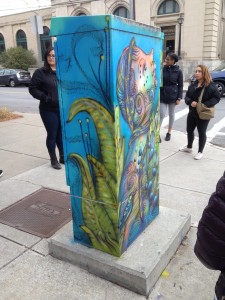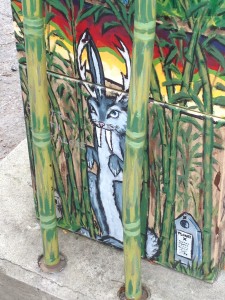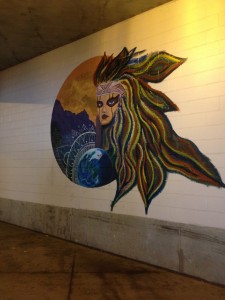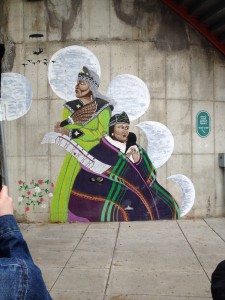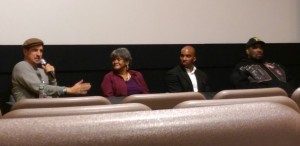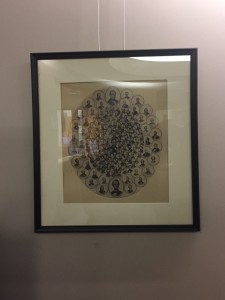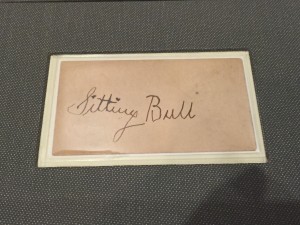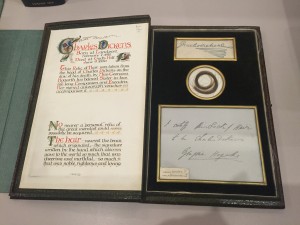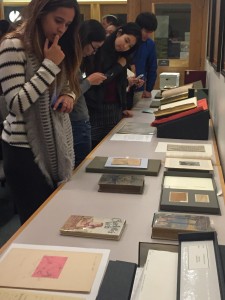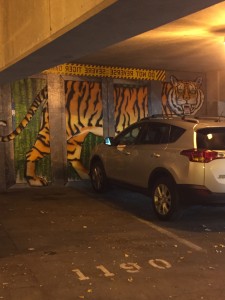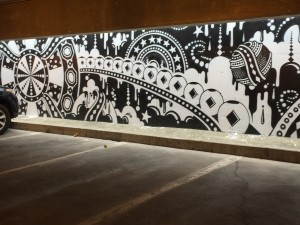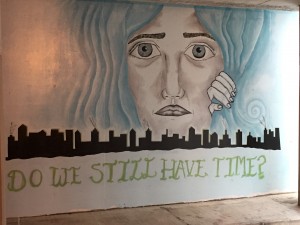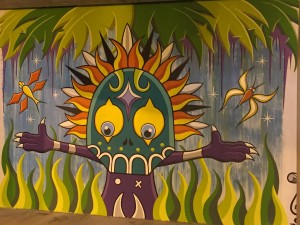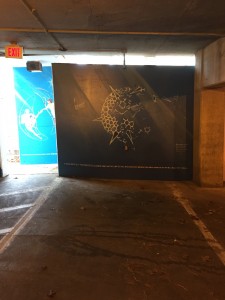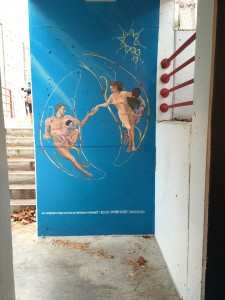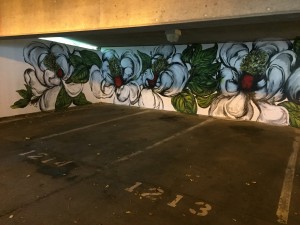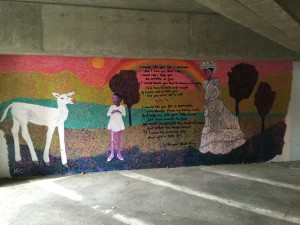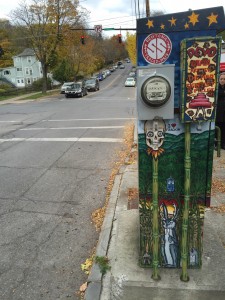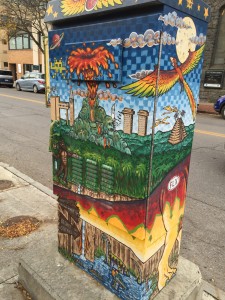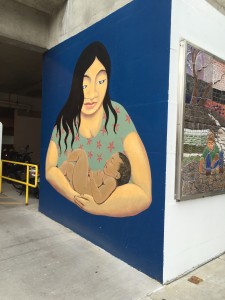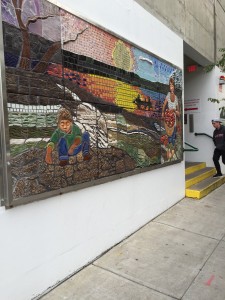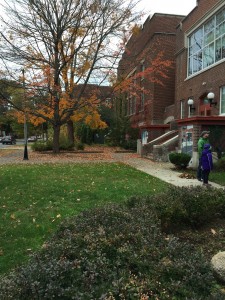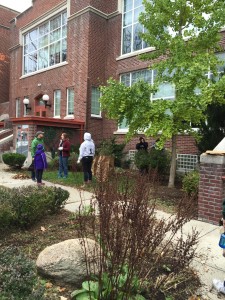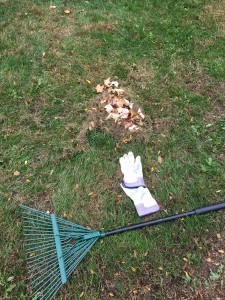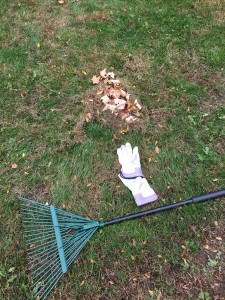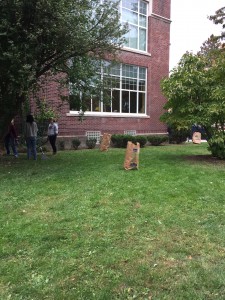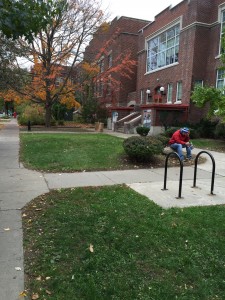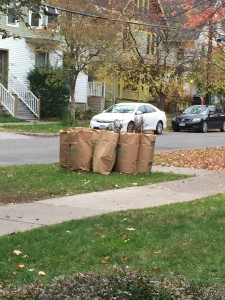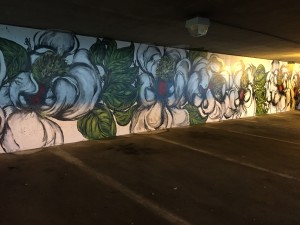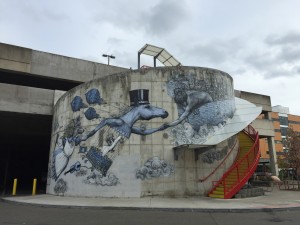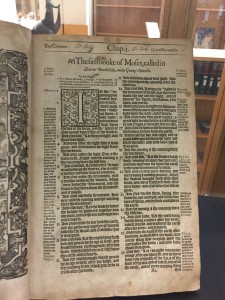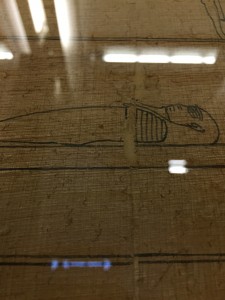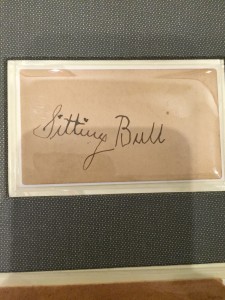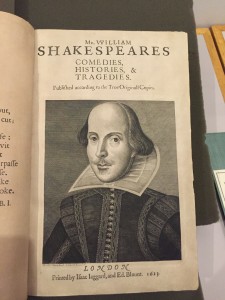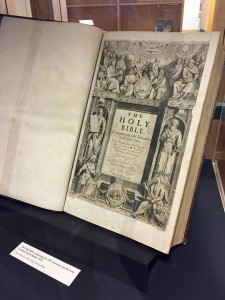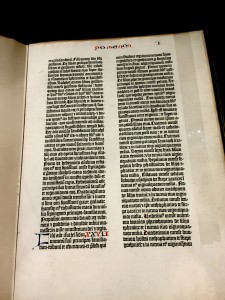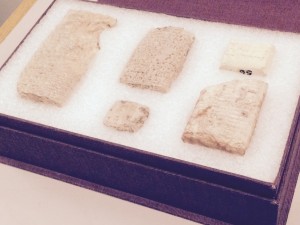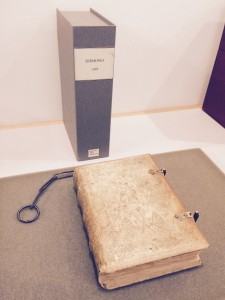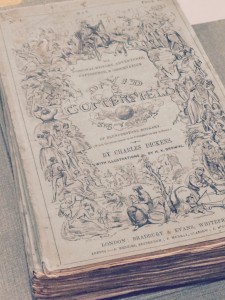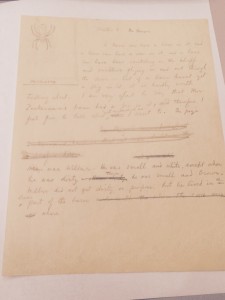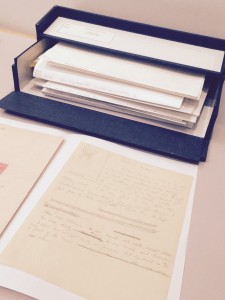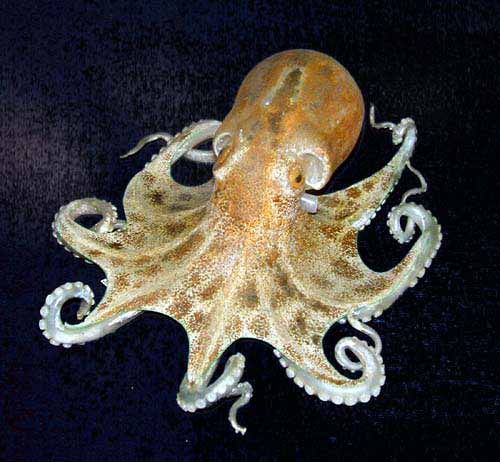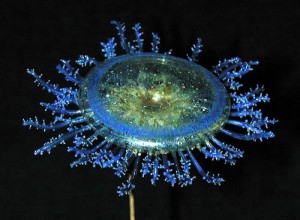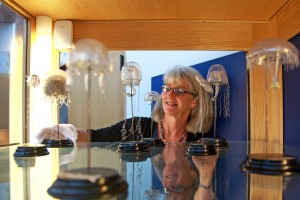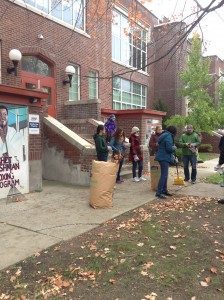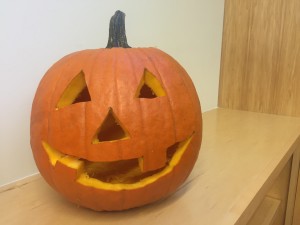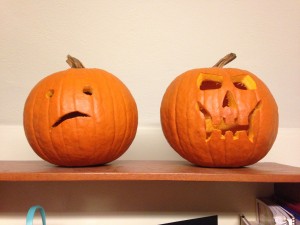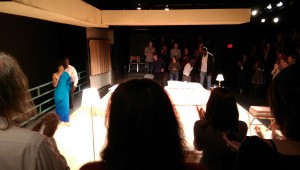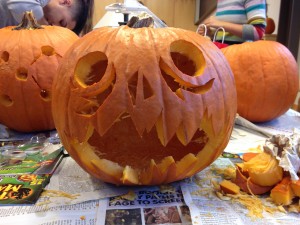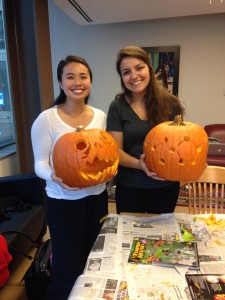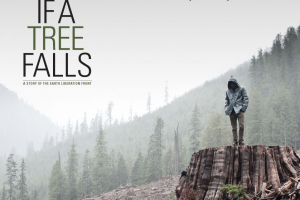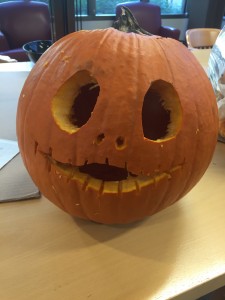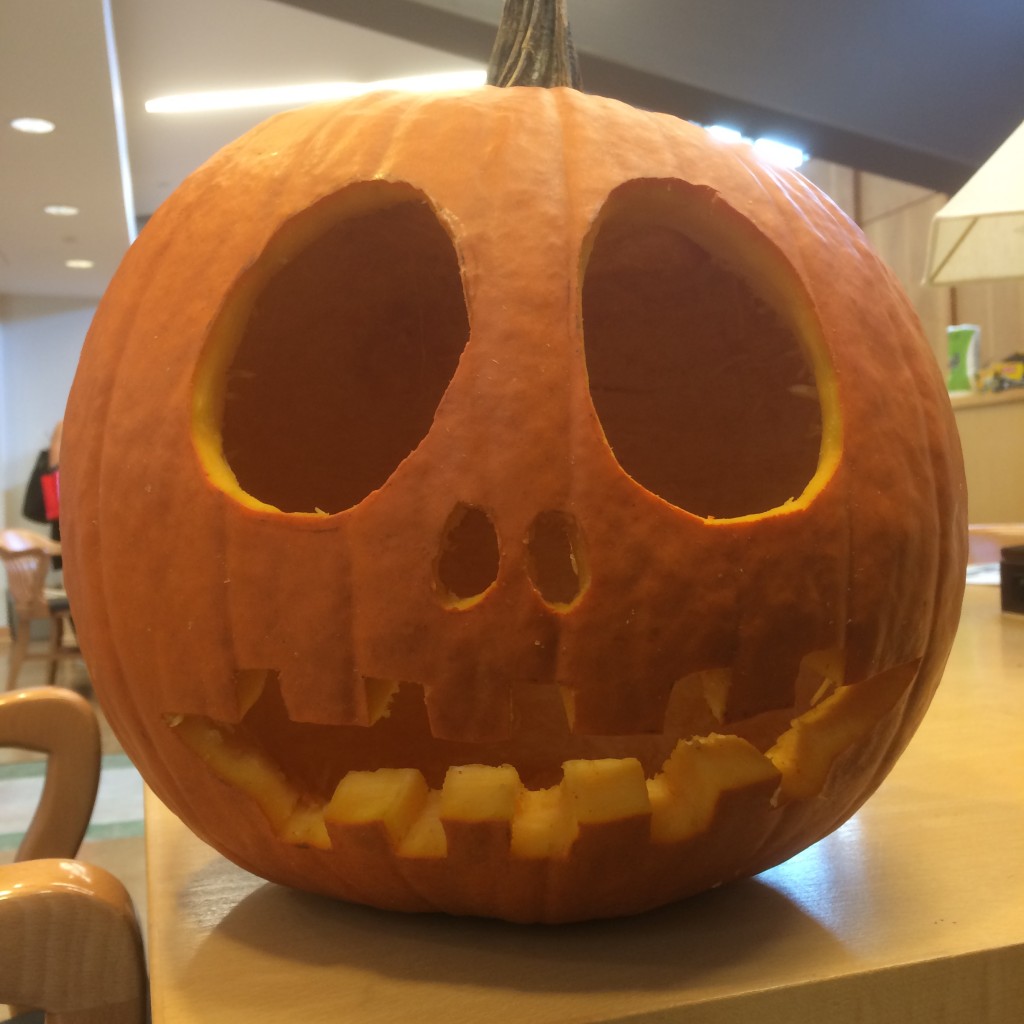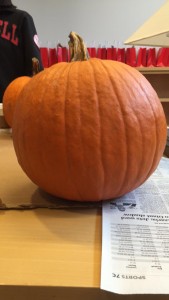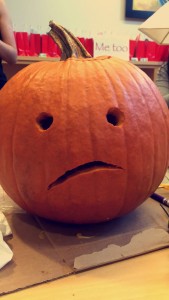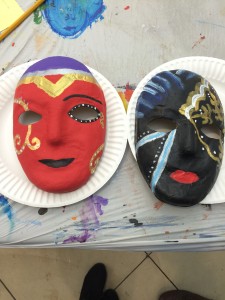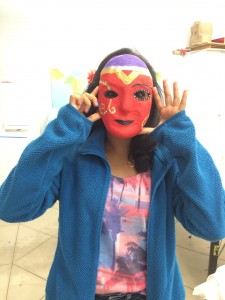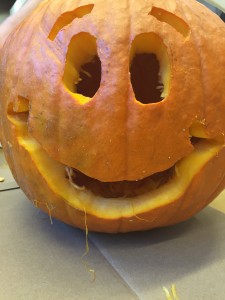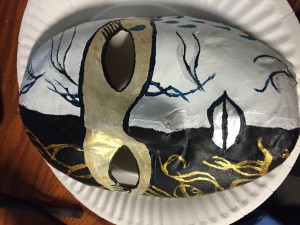I eat through Cornell Dining every meal of the day so seeing 2 men behind it all was like a celebrity moment for me. Chef Daniel, of our very own Rose House and Paul Muscente were the guests of our Rose Cafe this Wednesday and they shared what it is like to be behind the scenes in attempt at making sure we have food that we like ready to eat. I really like the initiatives Cornell Dining is taking with sustainability in mind. One of the initiatives that impressed me most is that they are trying to make vegetables the center of the plate instead of the typical meat as protein. Doing so is a huge challenge for them since they have hungry students that just want some meat, but what they are doing it has impacted me personally. The idea of rationing the chicken is not only for that though, but for food waste as well. Once the food is out, they have to throw it out so the less that gets on our plate, the better. It was also interesting to hear ideas that students had such as putting the deserts away from the fruit because of the temptation to grab a cookie instead of an apple. I remember that at Appel, I would always grab a fruit on my way out since it was by the door and I would be lazy to get deserts because they were hiding behind the soda machines. Basically, this cafe made me understand the crazy things that have to happen for us to get the meals we get everyday. Personally, I hope to be more considerate and appreciative of all of that when I go into the dining halls.
Carl A. Kroch Library
I cannot believe I am almost 3 semesters in and I JUST went to Kroch library. I learned so much from the time we were there that I made myself go back to explore the present exhibit, Gods and Scholars.
During the presentation, I learned that there is more to Cornell than Mann, Uris, and Olin; There are 18 libraries on campus, including the Carl A. Kroch Library which is full of primary sources and artifacts. In fact, they even have a vault in there which is the most secure place on the Cornell campus. It is the size of a football field and completely environmentally controlled to protect the many artifacts. In the vault is also Ezra Cornell’s bank safe.
The coolest part of this visit was seeing a lock of Charles Dicken’s hair, the plans for Charlotte’s Web, and a book of Shakespeare’s collection.
All in all, super great event!
Beyond the Story
On Friday, I took my first trip to the Kroch Library. While we were there, we learned about the rare manuscript collection and some background history of Cornell. Learning both history of Cornell and about these rare manuscripts were very interesting.
One of the first books we saw was a book with a chain on it. When first showed the book, I was not sure what to think about the fact that there was a chain. But, we were told that the book belonged to a monastery and that it was chained so that it could not be taken from its place. The book was also hand printed and took a very long time to make. To me, this was the biggest eye opening thing we learned about. I was taken aback by the way these books were made and had to be kept under such protection. To see where people spent so much time putting books together and protecting them was very interesting. In addition to the chain, we also saw the hand work done on the inside of the book. There were hand done letters on every page that means so much time was spent making this book. This to me was really impressive. It reminds me how important our knowledge is and how lucky we are to be here with all these books at our fingertips. It also shows how much time and technology has changed. This book and the story behind it really caught my attention and made me think a little differently when it comes to my experience here.
Some other very interesting things we saw were the first draft of E.B White’s, Charlotte’s Web, along with a book that was at the death of Sitting Bull. I am glad that I went on this trip and I was able to experience such cool things that I otherwise would not have seen.
Bringing Shakespeare to Life
Attending last night’s performance of Hamlet was a truly unforgettable experience. The play was a screening of the production from the National Theatre in London starring Benedict Cumberbatch as Hamlet. I had read Hamlet in high school but never seen it performed, so I was excited to see how this production would bring Shakespeare’s classic to life.
The one thing that initially surprised me about the production was its mixing of different time periods in the costuming of the characters. The first scene opened with Hamlet listening to big band music on a record player, and many of the characters including the King and Queen were dressed in 1940s era clothes. Hamlet, however, wore sneakers and a hooded sweatshirt for most of the play, and his friend Horatio had tattoos and a backpack. I’m not sure what the significance of these costume designs was supposed to be, but I was surprised at how smoothly I felt the words of the play fit into a more modern setting.
For me the highlight of the performance was Cumberbatch’s brilliantly nuanced portrayal of Hamlet, in which he was able to show both Hamlet’s overpowering grief for his father and his humorous side in the comic scenes. My favorite scenes were a few of his soliloquys during which the lights would focus on him while the rest of the cast was moving in slow motion in the darkness behind him. I felt this staging beautifully emphasized how Hamlet’s internal struggles alienated him from those around him.
Watching this production gave me a new appreciation for this classic, and reminded me that reading Shakespeare can never compare to seeing it performed on a stage.
Cornell Dining: A Craft of Culinary Excellence
Paul Muscente and Chef Daniel presented an informative and insightful look into the logistics of Cornell Dining, a system that requires serving nearly 2 million meals a year. The manpower, coordination and efficiency required to keep that running smoothly is mind-boggling. Additionally, there have been initiatives introduced to better balance a student’s diet, such as 5 Days of 5 where students are challenged to eat 5 cups of fruits and vegetables each day for 5 days. The social element of posting pictures of those participants’ undoubtedly colorful plates on Instagram was a excellent way to further engage students.
This talk also allowed attendees to ask questions that one might not necessarily have the chance to, despite the amicable nature of the Cornell dining staff. The rationing of meat was something I was curious about and they had a sound explanation: promoting a better balance with protein. That being said, because of the freedom of choice inherent in an All-You-Care-To-Eat facility, one can request for a larger portion. I am not sure if that is always true because I tried it myself today and server was not really receptive to it. Your mileage may vary I suppose.
Cornell Dining is highly conscientious of how the student population feels about the menu every day, one way is analyzing food waste. Chef Daniel goes through the waste multiple times a day to gauge whether a menu option is popular or unpopular, if the food quality is up to standards, etc., and takes measures to ensure the students’ dining experience is consistently exemplary and improving. The combined efficacy, dedication and craft of Cornell Dining allows them to achieve Top 10 in Princeton Review‘s ranking for College Dining.
The Masterminds Behind Feeding Cornell’s Brains
I was particularly interested in attending this event with Paul Muscente and Chef Daniel because I used to work in Rose Dining. Because of that, I know how hard it is to work 5-hour shifts focused primarily on feeding people and making sure everyone is eating clean and cooked food. I can’t even imagine having to manage something as large as a dining hall, let alone Cornell’s entire Dining operations. Mr. Muscente told us that they serve 2.289 million meals in a year, which boils down to about 19,000 meals per day. That number is so ridiculous that I can’t even fathom it. He said there are about 600-800 students working for Cornell Dining every day. That’s almost like 1 person serving 24 people at the same time. Although I do really support Cornell Dining and I wish that it can continue these operations, it really was hard for me to juggle working in the dining hall and studying for tests/writing essays/doing homework. If I could suggest one change to dining right now, it would be having the option of choosing shorter work shifts. And it may be more complicated to get the right amount of staff for each half shift, but it’s much more flexible for students. Like those who can’t make it to the beginning of a shift can make it to the 2nd half if there is an option for that.
To go on to the main idea of my blog post today, I was actually surprised at how much creativity and thought is put into creating the menus and meals for the students. Chef Daniel mentioned that last semester there was a 5-cups of fruits and vegetables challenge going on and the idea behind that was so students would make vegetables the center of their plate, rather than mounds of protein. He said these motives challenge them to get creative and come up with different ways to entice students to eat vegetables. He talked about how he incorporates whole grains into foods that we don’t even know contained whole grains. Although I didn’t stay for the entire time to hear him talk about some examples of this, I do think some of the tactics work. I think the strategic placing of carbs right next to vegetables makes people get the food in an assembly-line sort of style, so they take vegetables with them when they eat. Overall, I really think Cornell Dining does an amazing job of keeping students fed and their brains healthy. One day, when I graduate, I hope that there will still be continual progress in persuading students to eat healthier.
Cornell’s “Hidden Treasures” Aren’t So Hidden
Unlike most of the students at Cornell, I actually did not know that Cornell was home to a vast amount of primary resources. And when I heard about it, I didn’t think much of it at first. That’s why I think the Kroch Rare & Manuscript Collection Tour really helped me realize how blessed I am to be at Cornell. What’s more exciting is the fact that all of these resources are meant to be shared with us (the students!).
One of the first things we got to see was the plaque that Abraham Lincoln signed that acknowledged the Emancipation Proclamation (if I recall correctly) and we found out that only 12 of them were signed because the Legislature was angry that Lincoln didn’t go through Congress first before passing it. It’s actually pretty surreal that there’s something that only 11 other people/institutions in the WORLD have access to. I also had fun looking around at the other artifacts and primary sources the Kroch Rare & Manuscript Collection had in that area. We were, then, moved into another room with a lot of literature.
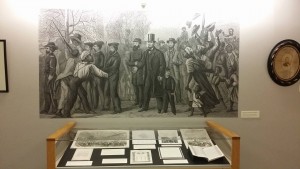
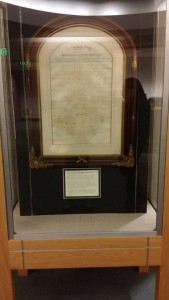
In the new room, we were able to see (sort of) a timeline of primary sources. Starting from thousands of years ago, there were small stones with codified rules (?). According to our historian/tour guide, they were probably the earliest pieces of evidence that codified language existed. I actually went up closer to see the stones, but the way the stone was carved made me cringe a little (some sort of phobia, I suppose). However, I was particularly excited about the Shakespeare book. I was a Theatre major before I was an AEM major, so being able to see one of the original books/compilations of all of Shakespeare’s plays is extremely interesting to me. I really wanted to touch it, but our guide told us about how the books and artifacts are extremely delicate and they’re not something people can touch carelessly. I was particularly interested in a sonnet that I had done as a monologue once in an acting class (Sonnet 97) but apparently this book didn’t have the sonnets. So although it was kind of a bummer… I was quite content with being able to see (and slightly touch) one of the original copies of the Shakespeare plays compilation.
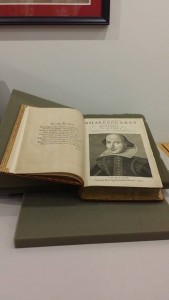
Interesting movie of ocean creatures
On Wednesday I attended the lecture about oceanography. I am very sorry that I went in late and only watched a part of the film. There are amazingly colorful creature in the sea and the professor seems to be passionate about the subject. She also recommends the intro oceanography class to us. Perhaps I will take it some day. During the charter days events this spring, I also saw professor Harvell giving a lecture at an ecology panel. She also show cased many gorgeous ocean creatures. I think it is really admirable that she chose this seemingly unusual career path and has become a great experts at it. I also want to learn more about the environment.
Cornell Dining, best dining
While the discussion seemed to be driven by the students involved in the service/dining industry, it was interesting to hear both the comments of the dining staff and the questions that students had for them. In terms of responses, there was one that stood out to me, because I know that it is untrue. The dining staff was asked about meat rationing in the dining hall system, and the speaker stated that meat would never be declined to a student that requests more when being served; I have experienced and seen, on multiple occasions, a refusal to serve more than one small scoop of meat at the dining halls. Besides this, I had no issues with what was stated at the event. It was interesting to hear the attempts to improve health and reduce waste in the dining system. I also received an answer to the most pressing question, after the event; Paul Muscente confirmed that North Star dining hall and Robert Purcell serve two different types of soft-serve ice cream.
Would a sea of glass make a more fragile ocean?
If ever there has been a Café series event that has made me reconsider my future career goals to instead one day drop everything to pursue a passion, it was easily yesterday’s talk with Drew Harvell. It was clear by her enthusiasm (and the career-long dedication to the project) that she is very passionate about the marine ecosystem and the glass models that are being restored. The idea of traveling the world to study marine life and comparing the findings to century-old artwork is somehow, dare I say, cool in its very essence. To add to this, her work has already seemed to immensely improve documentation of marine invertebrates, and even the study of pathologies in these marine ecosystems. While this may not seem impressive to some, there is great value in increasing our knowledge in such a way in any field; furthermore, the health of marine ecosystems has enormous economic and public health implications, in relation to the commercial seafood industry.
Ration of Food
Yesterday I was able to attend and participate in the Rose Cafe series with Paul Muscente and Chef Daniel. It was a very interesting and educational discussion. I really apprecaited that we were able to ask so many questions, and that they were so open and honest with the answers.
To start, I was unaware of the logistics that went into making cornell dining a top 10 dining school. First, cornell serves over 22000 meals a day, which is amazing. Additionally, each dining hall’s meals rotate weekly, (minimum), so you can theoretically go several weeks without eating the same meal. It’s amazing the variety of dining that Cornell offers.
What I found to be interesting is the way they determine the success of a meal. They mentioned they spend a large percent of the time checking the type and amount of food that gets thrown away. That indicates whether or not they should continue that meal, or if they should make less of it in the future. I thought that was very clever.
I asked what the new initiative to limit the amount of meat served to people, and they mentioned it was both for waste management, as well as for health reasons. My question to those reading this: what are your thoughts on this new initiative? Do you think it also has to do with saving money? Do you think they should or will limit the amount of cookies you can take, since they claim it is for health reasons?
I’m a little unsure if I believe that it is health related as they do not limit desserts which are much worse than having more chicken.
The Paradox of Technology
While watching the beautiful documentary Fragile Legacy, I noticed an interesting theme that spoke to an interesting paradox of technology. First, these beautiful glass figures represent the meticulous craftsmanship of the people that worked endlessly to create a near perfect replica of the sea critters. This was in the 1800s however, and they were stored away and forgotten for some time. Then, when they were rediscovered, they were able to be restored using today’s technologies to repair them to what they once were. Thus, technology saves us this time.
However, humanity’s use of technology has become detrimental to the environment, causing global temperatures and carbon dioxide levels to rapidly increase, warming the oceans, and directly damaging marine ecosystems. Clearly this is a negative side effect of living in the modern world.
On the other hand, we have developed ways to encourage the regrowth of the marine systems we damaged, which mitigates the issue a bit. There are Marine Protected Areas that allow sea creatures to refresh their populations and continue to live undisturbed. Moreover, using advanced technology, a scientist was able to diagnose the reason for the depletion of starfish quickly. This diagnosis would not have been possible without the sophisticated tools scientists use today.
Yet, we still continue to pollute the environment with no regard for the long-term consequences. It is easier to find the root of the problem and attempt to resolve it. There has to be some sort of widespread change, which has become clear to me after taking oceanography, and attending some of the Rose House events.
Modern technology creates a paradox in which it is detrimental to humanity as a whole, while at the same time facilitating us in making large leaps. Perhaps, as an economist would suggest, some of these particular detriments to humanity may warrant a cost-benefit analysis.
Forgotten Treasures
One of my favorite aspects that the Rose/Becker Café series brings to our Rose Scholar experience is that we are able to learn about something that is very unique in that we would not hear about it anywhere else. A great example of this was Drew Harvell’s presentation. In her presentation, she talked about the importance of the Blaschka Sea Creature models as well as how these pieces were almost forgotten in scientific teachings. It was amazing to see the skill and craftsmanship that went into creating these highly detailed pieces. The models were so lifelike that when looking at the model placed next to a photo of the real creatures, you could not tell the difference. It was also very interesting to find out that the glass models were actually used by Cornell professors to help demonstrate what these various creatures looked like. Also, for these amazing pieces to be sitting in storage is a shame. They should be on display for people to see and admire the life in our oceans.
We live here too, ya know.
“Save the nematodes!” just doesn’t have as good a ring to it as “Save the dolphins!”
However, marine invertebrates deserve just as much attention as we give to other sea creatures such as dolphins and sea turtles. Society at large tends to pay attention to “cute” sea creatures: the more evolutionarily advanced ones, and the ones we can relate to. There have been huge movements to stop overfishing and trash pollution, and the images associated with these movements tend to show sharks with their fins cut off or sea turtles with their heads stuck in those plastic soda can holders.
We tend to ignore the fact that the changes humans have made to the ocean over the years, from raising its temperature to polluting it with mountains of trash, not only affect marine vertebrates that have a prominent place in the media. The ocean is home to more than just pretty fish, adorable dolphins, and scary sharks. Although nematodes are not as cute as dolphins, they are in just as much danger if humans continue on our destructive path.
Professor Harvell’s talk and the documentary that she starred in helped open my eyes to this. If there had been a disease like the one discussed in the film that was killing sea lions up and down the West Coast (instead of sea stars), the media would be all over it and everyone would know about it. This is a problem, and I’m sure Professor Harvell’s documentary will help to spread awareness about protecting the smaller creatures living in our oceans.
In the meantime, someone come up with a slogan that sounds better than “Save the marine invertebrates!”
The Art of Science
Drew Harvell’s talk was really beautiful through the lens of art. The way she used the Blashka art to reveal the beauty and importance of marine life today was really impactful. The talk gave a new importance and meaning to art as a method of education.
I was really inspiring to see how accurate the glass marine life was to the actual animals, and how they were made in the 1800s. I had the opportunity to check out the actual pieces in the Mann Library exhibition, and they were really beautiful.
The art also made it very evident that species were growing endangered. All though we all know that certain marine life is growing endangered and extinct, it is not tangible to us how much the sea life is actually changing. The Blachkas did an amazing job making the changes in marine life evident and tangible.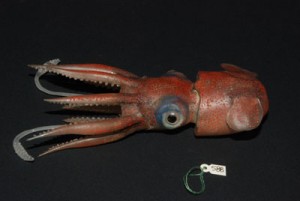
It was also very interesting to hear about the virus causing Sea Star death along the Pacific Coast. As a child growing up on the West Coast, I had often seen Sea Stars in tide pools. However, last summer, while I was visiting with my family, we saw only a couple sea stars. We had know idea why they were disappearing. Thanks to Dr. Harvell and her team, we now know why.
Behind the Scenes of Cornell Dining
I’ve always liked the food at Cornell, and I especially enjoyed the food on West Campus. But before participating in today’s cafe, I had no idea that so much was happening at Cornell Dining. It serves around 22000 meals a day, and handling waste food, determining allergens, and setting up dining times all take more effort than they appear to be. The cafe covered a lot of miscellaneous things, but what I appreciate most about Cornell Dining is that they have been constantly trying to improve and introduce new things. Today I learned that Cornell Dining has now launched its own app, which I believe would be very convenient since I personally like to check menus and dining hours on my phone a lot.
Cornell Dining also has been trying very hard to promote healthy eating, encouraging us to eat more vegetables and fruit and control the amount of protein we intake. The ‘Five Days of Five’ event last semester, increasing about 10% more vegetables in the food served and rationing the meat in the dining halls all serve for this purpose. I feel this is very necessary because consuming excessive protein does not benefit our bodies at all but the production of meat uses up way much more resources than producing vegetables and fruit. Having more vegetables and fruit and limiting our proteins would both benefit our health and the environment. I totally support what Cornell Dining is doing and I hope it could really help people improve their diets.
Kudos and Suggestions for Cornell Dining
Overall, Cornell dining is fantastic! We have great-tasting, high-quality food and there are always lots of options. Cornell has conducted successful initiatives to encourage healthy, sustainable eating and also works hard to accommodate students with dietary restrictions for medical and religious reasons.
Still, there are certain areas which I believe Cornell dining could improve:
- Lines. Okenshields (the only all-you-care-to-eat dining hall on Central Campus) is infamous for the long lines that form as soon as people finish their morning classes. And there are frequently long lines for specialty nights on West Campus such as Rose House’s Taco Tuesday. I believe that by putting a little thought into the problem and perhaps re-arranging the serving stations, these lines could be significantly reduced and students would be able to get their food with less hassle.
- Strict Policies on Taking Fruit. Despite the high meal prices (the required plan students who live on West Campus is $2,758 per semester) students are only allowed to take a single apple, banana, or orange out of the dining halls. Just last week I witnessed a student receive a JA (judicial action) for attempting to take extra fruit of the dinning hall. But honestly, aren’t there better things that the dining staff could be doing than meticulously checking whether students take an extra apple?
- Late Openings on Weekends. The West Campus dining halls don’t begin serving hot foods until 10 am or 10:30 am on the weekends which almost seems to encourage students to stay up late partying. For those of us who go to bed at a reasonable time and wake up early, it is inconvenient to have to wait several hours before we can get breakfast.
Thank you to Paul Muscente and Chef Daniel for teaching us about Cornell Dining. The scale of the operation (~19,000 meals per day) is extremely impressive and Cornell does a fantastic job. I know Cornell students are thankful for the food we have, especially considering that students at many other universities are not as lucky.
Declining Biodiversity in Coral Reefs
Last week, Professor Harvel joined the Becker Rose Café Series to discuss about the decline in coral reefs around the world and its impact on biodiversity. Professor Harvel has been working on the sustainability of coral reefs for quite some time and helped make a documentary on its biodiversity. What was really interesting is how she utilized glass models from the 1860s to compare its biodiversity to what is currently going on now. In 1860, the Blaschka brothers were requested to create glass models of sea creatures for students to use to learn. There was about 570 glasses produced for the marine biology major, but was later forgotten. Professor Harvel saw the glass collection as a lens to the biodiversity during the 1860s. She then got the idea of using these glass pieces as a time capsule to help determine the current state of coral reefs compared to the 1860s and see how many species have become extinct. The time capsule project showed that the marine ecosystem has been rapidly changing due to many factors. This and other problems arising in marine life has called for multi-national effort to preserve what is left of the coral reefs.
The rapid change in technology in relation to the change in environment was a key theme in the documentary. Technological change has caused long-term damage to the biosphere. As key stone species are declining, ecosystems are rapidly changing. But technological change has also helped us discover these environmental changes and find solutions to these problems. Without technological change, we wouldn’t have been able to discover an ocean virus that threatens many species of coral reefs. Professor Harvel’s talk was insightful of the how current tech change has spurred major impacts in our environment. I am looking forward to the glass pieces display in the Johnson soon.
Menus of Change at Cornell Dining
Today’s Becker-Rose Cafe focused on a topic that directly affects all of us students: food at Cornell. Chef Daniel and Paul Muscente provided us an inside perspective on why Cornell Dining is the way it is and new programs that have recently been installed. There are many initiatives within the Dining system that are under the umbrella of a larger “Menus of Change” program whose general goal is to promote healthy eating and increase sustainability.
One specific produce goal is to serve 10% more fruits and vegetables. This is a great aim and all of the great dressings, veggies, and salad toppings offered on West campus definitely promote healthy eating in this respect. However, it would likely further this goal to have an increased variety of fruits and vegetables available. I aways look forward to those infrequent nights when the dining halls serve strawberries and avocados, which always seem to be in high demand. They are perhaps more expensive to purchase, but as Chef Daniel pointed out, less resources go into preparing them (as opposed to preparing a chicken dish, for example) and they are very good for you!
The initiative to offer infused water as a healthier alternative to soda is also something that I personally take advantage of. This seems to be the perfect solution to the “healthy vs tasty” dilemma because the fruits inside the water add a bit of flavor. On a side note related to beverages, the apple cider offered at dining halls is very delicious and it is very nice that the cider is available to students for some time after “apple season” typically ends.
A slightly more controversial implication of “Menus of Change” is the rationing of protein dishes at the dining halls. According to Mr. Muscente and Chef Daniel, the goal of this is two-fold: to promote a plate that is half veggies, one-fourth starch, and one-fourth protein and also to reduce waste. However, despite Mr. Muscente’s claim that if a student wants more he/she can simply ask the server for more, in my personal experience this has not been the case. Rationing proteins has left many students feeling frustrated and with the sentiment that they are not truly having the “all-you-care-to-eat” dining experience that they are paying for. Moreover, taking extra trips to get another ration, and sometimes waiting on line for it, takes extra time, which busy Cornellians may not always have to spare. Perhaps the rationing is a good idea, but further research needs to be done to determine the correct amount to ration.
Although there is still potential for improvement, Cornell Dining clearly “towers above the rest” and I am looking forward to seeing what exciting new ideas they will implement in the future!
Catering to College Students
Today we were able to listen to and question the people who have one of the largest impacts on us during our time living on campus- the associate director of Cornell Dining Paul Muscente and Daniel Czebiniak the House Chef and manager of Rose House Dining. While it may not be your moms cooking, they are providing freshly cooked meals to you everyday, but then again they are providing over 19,000 meals a day. Not only are they filling our stomachs with delicious food and taking our stressed out minds off of prelims for a few moments a day, but they are also striving toward healthier food. Not only are the menus custom made for each dining hall, but they are also adapted based on what it is that we are eating and enjoying. If customizing a menu week after week for the taste’s of college students wasn’t enough, they also cater toward those with allergies. My sister is gluten intolerant and so to learn that there is a nutritionist she could work with and that the chef would custom make her a meal is incredible.
It was really nice to hear all the updates occurring with Cornell Dining and learn about the many resources they have available to students. One of these resources that I did not know about was that the nutritional facts about all the meals served in dining halls and cafes can be found online. I also found it interesting that the dining halls were moving toward having vegetables be the center of the plate and that we don’t necessarily have to wait on line if there is something later on in the line that we want.
Glass of the Deep Sea
On Wednesday, Professor Drew Harvell of Cornell’s Department of Ecology and Evolutionary Biology presented “Fragile Legacy”, a film made by David Brown. She expressed her enthusiasm with creatures of the deep sea and called to restore one of the most valuable resources in learning about the world’s past. Cornell is home to a collection of glass representation of ocean invertebrates, which were made by a famous father-son duo in glass making, Leopold and Rudolf Blaschka.
The film illustrated the intricate glass objects that could only be crafted with years worth of training and experience back then. Andrew Dickson White, Cornell’s first president, had set aside money to commission a set of these sea animals for the university to study ocean biology. However, this collection soon ended up in a storage house and only when Professor Harvell asked to restore this collection and bring it back to the Cornell campus did restoration begin.
But what is most valuable in restoring this collection is not in its aesthetic value, but in the insight it gives to marine biologists and evolutionary biologists. In the making of “Fragile Legacy”, Professor Harvell and a few of her colleagues when out on a quest to see if living counterparts of these glass representations still existed. Unfortunately, the world’s changing climate and well as industrialization has led to changes not only on land, but also in the ocean. After many failed attempts in searching for the common octopus, Professor Harvell and her team finally found it living in the oceans nearby the Mediterranean, where there was a body of water preserved for studies.
There has been many changes in biodiversity and Cornell’s collection of Blashcka’s Invertebrate Models give helpful and interesting insights in biodiversity. Evolution is constantly progressing and one of the most overlooked fields is marine biology. Research is constantly being conducted and the Blashcka models are only a portion of what the ocean offers.
When Glass Sculptures Aren’t Just Pretty
I attended Drew Harvell’s lecture on Cornell’s large collection of glass sea animal sculptures. According to Harvell, Cornell’s first President commissioned glass art from famous glass sculptors by the name of Blaschka. Our collection of water invertebrates sat unnoticed for over 100 years before they were rediscovered and repaired. They’ve been used in Harvell’s new documentary about how these sculptures were a ‘time capsule’ of water creatures over 100 years ago. Not only were the sculptures beautiful, but also helped professors here identify creatures that haven’t been seen a very long time. 
I was extremely shocked to see how realistic the glass sculptures looked! It was also refreshing to see Harvell use forgotten art for a scientific purpose.
This was absolutely my favorite one. I never knew glass sculptures could be so intricate and accurate. If you ever have time, you should look up the collection online or see it in Mann library
The Chef Experience
Before attending the talk on Cornell Dining, I did not know that more went into making and upkeeping menus and food that we see every day. In a single day, Cornell Dining produces over 19,000 meals. This is something I never take the chance to appreciate whenever I eat a meal at a dining. Which, I will start paying attention to because Cornell Dining makes an effort to cater to people like me: vegetarians. In addition, Cornell Dining believes that fruits and vegetables are not only healthy eating habits for everyone but also cut down on waste in our day-to-day lives. Also, I had no idea that Cornell Dining catered to people outside of Cornell and worked for the greater Tompkins area. Cornell Dining is so good at providing excellent dining hall food that it has ranked in the Princeton Review top ten university dining halls that give excellent dining.
One thing that upset me a little was that Cornell Dining does not plan on bringing back Cascadelis to Cornell. This is very unfortunate because I knew it was closed for this year, but I was hoping it planned on bringing it back in the following years. I would have been a faithful customer.
Sea Glass
Last week I attended an incredible talk about a Cornell professor’s attempt to discover all the marine life found in teh Blaschka models. The pictures of these models were absolutely incredible and there were times that I could not tell the difference between what was glass and what was alive. I love snorkling but the scuba diving that the video showed demonstrated just how beautiful our ocean really is. After her talk, I actually searched the Mann library for the models. Cornell offers so many incredible things that we don’t even know about so I enjoyed hearing about one more thing that makes Cornell amazing.
The discussion after the video after the viruses that different aquatic animals, specifically starfish, are getting sparked my interest. The professor effectively explained just why it is so devastating for these starfish to be extinct, which could very well be a reality soon. I know that fishing practices are terrible but I would never imagine that people would be capable of dynamiting coral reefs for a few fish. The video of the dead reef was devastating. The ocean is so big and, being out of sight most of the time, is a resource that we have really taken for granted. Conversations usually center around the water rising or pollution. The professor talked about the potential effect of rising water temperatures on the vast array of marine life’s ability to overcome these terrible viruses and diseases.
The Glass Ocean
Last week Wednesday, I attended the Rose Café featuring guest speaker Professor Drew Harvell. Professor Harvell is leading an effort to restore Cornell’s Blaschka glass collection. The Blaschka Brothers were glass blowers who sold their collection of glass, aquatic animals to Cornell. These items were meant to be educational tools to teach students about aquatic life. However, due to time and use, many pieces were broken down and eventually stored away. Thanks to Professor Harvell, the pieces of art are being restored and put on display at Cornell.
This Rose Café was enjoyable for many reasons. For one, it is always gratifying and uplifting to someone work on something that he or she is so passionate about. Professor Harvell’s love for marine ecology is very infectious and even inspired me to go visit the Blaschka collection myself. The amount of detail that each piece contains is unreal and is unlike anything else I have seen before. If you have not seen the collection yet, I would highly recommend at least stopping by. I also enjoyed being able to watch the movie she made about the collection. It was interesting to learn about the origins of these glass pieces and the effort it took to craft them.
The Beautiful Sea
This event was definitely one of my favorite Becker-Rose Café series thus far! I have always had an interest and appreciation for aquatic life. While I have scuba dived before, I have never seen something as beautiful as the organisms that the Professor saw underwater off the reef or depicted in the Blaschka models. I heard of the Harvard Blaschka glass before but did not know much about it nor did I know Cornell had its very own collection.
After viewing the glass pieces on the video, I was amazed at the beauty and precision that must have went into creating such pieces. Not to mention, Professor Harvell’s remarkable reconstruction/repair of the many broken pieces. When I heard that the Blaschka pieces were sitting on a shelf in a box stored away from display, I was amazed. The beauty in those delicate pieces was most certainly depicted in the images in the documentary where the real organism was pictured side by side against the glass piece.
The discussion prior to and after the video was also very enjoyable. Professor Harvell’s dedication and enthusiasm towards the subject matter made the lecture series event that much more intriguing. I will most certainly consider taking one of Professor Harvell’s courses during my time here at Cornell. I am excited to see what other people thought of this event as well!
Unique art with a function
I really enjoyed Professor Harvell’s presentation about the Blaschka glass models and marine life. I can’t wait to attend the show in the Spring to see them in person. The glass models provide a representation of marine life that can’t be captured in any other art medium. The film also showed some beautiful and unique creatures that I haven’t seen before. Marine life can sometimes look other wordily, and it is always a great experience to see a new species.
The history behind the pieces was also very interesting from their creators to how the pieces ended up with Cornell. Drew Harvell has done a great service for everyone by finding these hidden away pieces and leading an effort to restore them. She is doing an even greater service by leading efforts to better understand Coral Reef ecosystems and how to preserve them.
Art from Down Under
I switched things up this past week and attended my first Becker-Rose Cafe event. This lecture was a perfect fit for me. There’s something about nature that is so comforting to me as it was and still is the guiding force and inspiration throughout my 19 years. I used to collect those wildlife subscriptions that would come in through the mail and soon enough I would have binders full of all these informational pieces with unique animals I had no idea existed. This lecture reminded me of all the aquatic creatures I had seen in these pictures during my childhood. It was so interesting to me that the Blashkas would perform extremely intricate procedures in order to create these magnificent designs to emulate the real-life nature of these creatures. It also made me think that if a piece was to fall on the ground, the artwork would be lost forever. In the case of a damaged pieces, it warmed my heart to know that people like Drew Harvell and her team are so dedicated in preserving this art form, especially when it comes to preserving the true integrity of each living organism.
Old Treasures at Cornell
I have always known that Cornell has an incredible collection of books, artifacts, and ancient pieces. Although I have always been curious about exactly what we have, I never found the time to research and look into it. Last Friday I went on the Kroch book and manuscript tour where I learned about some of the amazing pieces our libraries hold. One of the first things that I learned was that Olin and Kroch Libraries have a huge safe where they keep all of their unique pieces and books under the Arts Quad. What blew my mind was that this safe is the size of an entire football field. I couldn’t even comprehend the millions of books and rare items we must have in that space.
The librarian who gave us the tour had brought up about 10 items from inside the safe so that we could look at them. He took us through history by starting with artifacts from 4,000 years ago and eventually ended with something that was only a few decades old. One particular book that I found incredibly interesting was an old book that used be housed in a monastery. It had a metal chain on it which we learned was their version of “library security” because the books would be chained to the wall and you could only read them there. Looking at the writing inside of this book was incredible because the first half was completely handwritten. You could imagine the amount of hard work that would have gone into making a book with such small print. The second half of the book was actually printed by a press, and I liked seeing the contrast between those two.
Another artifact that I really liked seeing was a letter that Mark Twain had written. It was a recommendation letter that Mark Twain had written to Cornell University on behalf of a professor who had applied for a job. This professor was ultimately given the job offer and he went on to work for Cornell for many years. I had no idea that the famous author Mark Twain and Cornell were related in any way, and it was exciting to learn. We also found out that he would spend his summers in Elmira, which is right near Ithaca.
On top of these two items that I mentioned, there were more that were showed to us and many more within the library. It is important to note that all of these items are accessible for undergraduate students to use. For example, if you are working on a project about Shakespeare’s writing, you can request to work with the books that originally printed his plays centuries ago. I didn’t know that these times were available for us to use but it is amazing that they are.
Connecting Art Through Time
I walked through the atrium of Corson-Mudd Hall almost every day last spring, but I never once stopped to notice the restored Blaschka glass models on display there. I passed through Corson-Mudd only as a shortcut to the lab I work in on the Biotech quad, so I was almost always rushed and distracted. Still, I would have thought that at least once I would have given the models some attention – it took Drew Harvell’s talk and film to highlight something that had been right in front of me.
In a similar way, Leopold Blaschka first noticed the creatures that he eventually modeled for Cornell while he was stuck at sea. He didn’t originally pay them much attention, but once he was forced to stop and observe them closely, he was awed by their variety and beauty and wanted to show them to others.
Dr. Harvell and David Brown took Blaschka’s work and made it even more unique than it was in his time. They not only captured images of creatures that are being endangered by pollution and human activity, they also created an intersection between past and present that was wonderful to watch. Seeing the Blaschka models right next to their present-day, living counterparts showed both how the sea has changed and how some of the creatures in it are exactly the same when Blaschka watched them. This kind of opportunity is rare, especially with models that are purposely so exact and creatures that are so rarely seen.
Now that I know about the models and where they came from, I’ve stopped a few times to look at the ones on display in Corson-Mudd. I’m grateful that I can now appreciate them for the teaching tools, pieces of art and historical records that they are.
Sea Glass
Professor Harvell’s presentation of the Blaschka Glass models and her documentary work of them providing an interesting look into the way that science is connected to history. Oftentimes, when we think of science here at the university, we tend to look at it as independent of time (physics majors, please resist the relativity joke). Even when we do think about the temporal component of science, we only use time in the evolutionary sense. Besides those of us in rather niche programs like STS, we rarely look at the history of science and how we got to our current level of knowledge.
My appreciation for Professor Harvell’s presentation is that it addresses this precise gap in the typical lenses that we use to look at science. It’s quite an interesting this to see how people in the mid-19th century imagined the creatures of the deep, and it’s remarkable to learn that we are still using their models as the standard from which we search the seas.
Additionally, the artistic component of the glass pieces is also astonishing, though this warrants less explanation. Both the detail, accuracy, and unqualified beauty of the pieces is extraordinary. To this point, when Professor Harvell’s asked us to identify which image contained a glass piece and which contained an actual organism, I guessed incorrectly, as did other seated near me.
Capturing the Beauty of the Coral Reefs
Last Wednesday, we welcomed Professor Harvel as our Becker-Rose Cafe guest. She screened David Brown’s film, “Fragile Legacy”, a documentary about the sustainability of marine ecosystems. Professor Harvell has worked on coral reefs in the Mexican Yucatan, Florida Keys, Hawaii, and Indonesia. The film showed how glass makers attempt to capture the majestic beauty of the sea creatures. Glass makers produce thousands of glass models for museums and teaching models and these models capture a diverse array of species, from sponges, jelly fish, corals, mollusks, sea slugs to starfish.
Previously I had noticed but the wonderful biodiversity and beauty of these creatures but had not thought much more of it. According to the documentary, the wonderful biodiversity is often passed over unappreciated, and we will never ever have the opportunity to admire their beauty and central role in in the ecosystem before they are gone unless we take action on climate change. The coral reefs are central to maintaining a balanced ecosystem. Overfishing and costal development has had a negative impact on coral reef ecosystems. Increasing pollution and carbon dioxide content has triggered an extinction crisis. These are all events that I am well aware of, but this documentary has shown even farther reaching implications to consider. It shows how climate change touches every living organism on the planet, every ecosystem and every habitat. The documentary has made me more aware and appreciative of our species rich coral reefs and environmental/conservation challenges.
Beauty under the sea
Last Wednesday I attended professor’s Harvell documentary on the seas/ Blaschka’s glass pieces. The pieces looked really detailed, realistic, and beautiful. I think that for about half of the film, I was just in awe because the pieces looked amazing. I was surprised when I saw that Cornell had a collection of Blaschka’s pieces. That’s definitely something that I would definitely want to check out in the future. I also found it interesting how the glass pieces can be used to teach about marine ecology. The glass pieces can probably be treated as a museum artifact and serve as a model. Towards the very end, the film talked briefly about why we should protect our oceans .
Overall, I liked the documentary because I was exposed to something that I had never seen or thought about. I think that the part of he film that will stick with me is Blaschka’s ability to produce something so intricate and detailed in a time were there was no technology to facilitate this process.
The Intersection of Art, Science and Conservation
Last Wednesday, I joined a large group of Rose Scholars and watched the documentary Fragile Legacy. It talked mainly about the Blaschka glass models of invertebrates in the ocean, but also touched on the sustainability of marine ecosystems. While it was a powerful combination of art, science and conservation, I do think that the movie could have been a little bit longer and gone into even more depth about the sustainability aspect of it all. It clearly states that things have changed dramatically in the ocean, but it gives quite a gentle push toward change and does not give as lucid directions as to how this change could come about. But maybe that was never the intention with this documentary? Maybe its purpose was instead to stay away from causing people guilt, and to be an eye-opener that might appeal to people who are not completely comfortable about having the knowledge of climate change. And the documentary does deal with exactly those feelings. There is a clip when a man (I believe the director) sits on a rock and talks about the enormous feelings that climate change produces in the people who choose not to look away from the issue. And I do think that this movie’s purpose was maybe not to educate fully, but to serve more as a push for people to educate themselves.
After the documentary was shown, we talked to Professor Drew Harvell about the process of making the movie and her role in it. We also discussed the loss of the starfish along the western coast. She explained for those who did not know, what a keystone species is; namely a species that regulates the abundance of a lot of other species. She however hesitated to draw too strong of a line between global warming and the deaths of the starfish, choosing instead to settle on the fact that while we do not know for sure, we can know that the process of disease spreading was sped up by the increasing temperatures in the oceans.
Overall, I thought this was a good and thought-provoking movie, and I wish that more people would see it- especially people who are hesitant to take on those enormous feelings of fear related to climate change- because it does a good job of explaining the issue at hand in a clear manner without being too harsh.
Representations of nature
Like just about everyone who attended Prof. Harvell’s documentary screening, I was deeply impressed by the quality, the detail, and the magnificence of the Blaschka glass pieces. They are stunning likenesses, and its amazing, inspiring, and humbling to remember that they were created in the late nineteenth century with fastidious observation and handcrafting in place of today’s more advanced technology. I was also interested by the function of the glass creatures – as teaching models. While instruction with models still persists today, I can’t imagine such fragile and unique pieces of art playing that role. Without the alternative of video footage and projector, or mass manufactured plastic model, the use of glass seems much more natural. In a sense it’s sad that the classroom functionality of these incredible artworks has become obsolete. It confines them to glass museum cases, where they will be admired, but won’t play such an integral role in the study of the life they represent.
Dr. Harvell’s search for the marine life recreated in the glass sculptures is likewise an inspiring, humbling, and, in some cases, troubling thing. Like the Blaschkas, Dr. Harvell and David O. Brown’s work harnesses the power of human technology and observation to give a wide audience a closeup look at some of the oceans’ most bizarre and beautiful life forms. For most of us (I assume) the times that we really turn our attention to these organisms are few and far between. Fragile Legacy asks us to do just that. Looking at these creatures, I am amazed by their diversity and their outlandish forms. What’s also striking is their fragility. Pollution, climate change, and disease are true threats, as certain moments of Dr. Harvell’s search (like the discovery of reefs filled with dying sea stars) remind us. Reminders alone don’t solve the problems plaguing ocean life, and the natural environment more broadly, but they’re necessary if we’re going to commit to altering our behavior to address them.
Who can write in the city’s history books
Who can create art in the spaces that the city owns? Only those granted formal permission by the city and its chosen members.
As a NYC native and an advocate for the occupy-what-ever-space-you’d-like-because-that’s-what-this-society-has-taught-us movement, I do not completely approve of a group of people deciding what can be considered art (nonetheless, good art) in the city of Ithaca (or in any city for that matter).
Who are the artists? What social groups do they belong to? Are they all men, majority men…are they all white, majority white?…are they all heterosexual, majority heterosexual? What political, religious, ideological beliefs do these artists have? And are they representative of the multitude of cultures, experiences, languages, etc that comprise of it’s surround?
In NYC, anything that is done by a person of color is considered vandalism. But when Bansky does it, it is revolutionary; art.
I question what this society considers art and what it considers vandalism, and the fine line an artist must dance on to find the balance of expression.
How can we, as a society catalyzed by a dominant (white, male, heterosexual, able, etc) culture, learn to accept that all forms of art (whether legal or illegal) are forms of art?
Under the Sea
As a student enrolled in Oceanography at the moment, this was a great opportunity to learn more about coral reefs and biodiversity. An interesting point in the conversation was when a student challenged Professor Harvell about the massive death of sea stars in west coast as a result of unusual warm water.
A part of me wants to play devil advocate and wonder, species have always been evolving and/or dying out and mother nature seems to go through cycles of major extinctions. We have already gone through 5 of them (previous ones not being human induced), so is a 6 mass extinction really even avoidable? There is actually such a thing as “Intermediate Disturbance Hypothesis” which states that disturbance maximizes species diversity by periodically removing competitively dominant species and allowing less competitive species to reestablish themselves. So if this is indeed correct, perhaps species such as starfish need to be “periodically removed” for their growth to stay in check or help other species to thrive. This also leads me to question whether preventing a 6th mass extinction is really even possible. To be clear however, I do not condone the human induced polluting of the ocean and earth overall. I am just wondering if pollution has simply sped up a natural earth cycle?
Now tying this back to the film shown by Harvell, I think her argument for saving marine life is lacking. It seems like her argument is, marine life is pretty so we should save it. I’m sure her interest is deeper but it just came off that way to me. Overall though, interesting film.
Underwater Life in Glass
I’ve always had a great interest in underwater life. Yes, I was one of the few kids who enjoyed the underwater life documentaries shown in middle school science classes. It was just as exciting to me to see the mysterious creatures right here on earth as it was exciting to see the millions of galaxies so distant from earth. The diversity in science and how us, humans, are able to not only understand science but use it to create our own world was amazing. It is one of the reasons I became an engineer. This awe for science was reintroduced to me this past Wednesday when I attended Becker/Rose Cafe Series with Prof. Drew Harvell. The discussion was about the glass collection that Cornell bought during President A.D White’s time. It is a vast collection of underwater creatures perfectly recreated in glass. I was awe struck at the level of detail and complexity of each piece of glass.
The talk showed two fantastic topics. At first sight of the glass pieces you cannot but help to be struck by the elegance and structural integrity of the pieces. In addition to admiring the craftsmanship of the collection, the audience learns about the diversity of life on earth. Even the most common of these creatures, for example the jellyfish were breathtakingly beautiful. Prof. Harvell shared with us that these were once used as study materials to show students taking biology classes the exact form of the creatures. I would have really enjoyed to be in a class where these were used to help students. However, these were later put in storage in the Corning Museum of Glass. For many years now, Prof.Harvell has been working with a glassmaker to restore these glass pieces.
I really enjoyed this talk not only for the beauty of the glass pieces but also because it reminded me of my initial interest in the sciences. As a child, I was amazed by the numerous and exotic creatures of the sea. It helped foster my excitement for the sciences. As an full time student now, I can sometimes lose track of the things that used to excite me. The talk with Prof.Harvell reminded me again of the creatures that I once started at in awe.
Historical Books, Books with a History, and Occasionally Books with Bulletholes
The lights were dim in the cramped room– “to minimize damage” the librarian said as he cradled a 15th century book in his hands. All the items laid out on the table in front of us were precious bits of history. There was an ancient cuneiform tablet from the start of civilization, one of Shakespeare’s folios (the earliest collection of all his works), a stack of Charles Dicken’s paperbacks, and even a book with a bullet hole from the gun fight that ended Sitting Bull’s life. It was exciting to examine a letter in Ezra Cornell’s hand speaking of his visit to the White House, where he met Abraham Lincoln in person (though not quite as exciting as seeing Abraham Lincoln’s own signature on a memorial copy of the thirteenth amendment– I was truly in awe of that faded scrawl). Mark Twain’s writing also made an unexpected appearance, in the form of a recommendation letter for a German professor (who then proceeded to teach at Cornell for two years). E. B. White, a Cornell alumnus and the author of the classic children’s book Charlotte’s Web, had drafts of his work laid out on the table along with his sketches of the farm. It was amazing to see all of these precious items up close and to hear their stories.
(I have to admit, even with all the key pieces of history laid out in front of me, what thrilled me the most was seeing that Sitting Bull signed his autographs with hearts above the i’s. Even though the librarian insisted that Sitting Bull was not channeling his inner adolescent girl, I like to think the cutesy hearts were a deliberate touch.)
The Blaschka Collection: Evidence of a Hidden but Disappearing World
When I first saw the slides with the pictures of the Blaschka glass pieces, I thought that they were pictures taken of the living creatures that they were created to mimic. I felt a sense of awe, how could two people capture the beauty of these creatures so well at a time when technology was limited?. I have been to the Corning museum of Glass before and have seen the wonders that are possible with glass, however nothing I have seen before has had such a lasting impact. The idea that the creatures these pieces mimic are going extinct is a definite eye opener. I particularly found Professor Harvell’s documentary to be moving. Seeing the actual sea creatures and then also seeing the glass pieces made me realize how much attention to detail went into creating the pieces.
I also found within this film and discussion, another reason why we as humans are responsible for finding a solution to global warming and climate change. Helpless creatures such as the starfish and being killed by a virus that is allowed to spread more easily in the warmer water temperatures. We have the means to discover a solution and the slow disappearance of these many creatures should be a warning to us that we need to find it soon. Overall, I am still wondering how the Blaschkas were able to form such magnificent class pieces of creatures that live deep in the sea without the help of modern equipment such as oxygen tanks.
Blashka: Warning and Inspiration
I found the presentation on the Blashka to be as alarming as it was inspiring.
The skill of the Blashkas is amazing. The attention to detail, in everything from form to color, reveals both a deep commitment and mastery of their craft. I can’t begin to imagine how—during the 1800s— these works were produced. They even seem to be beyond the reach of technology we have today. And the fact that the Blashkas were able to make these models without viewing photos of the creatures is even more astonishing.
That Dr. Harvell had to search for these species is alarming. Why have we allowed such beauty to vanish from our earth? How can we stop ourselves from causing further destruction and tragedy? As Ben suggested in his post “The Power of Art,” I too believe that art can serve to inspire change.
Ithaca’s Outdoor Art Museum
Last Saturday I went on a fascinating tour of public art in Ithaca. I was amazed at how few of the artworks I had seen before, despite having lived near Ithaca for most of my life. On the course of the tour we saw examples of murals on parking garage walls, electrical boxes, and underneath bridges. Each one had a different theme, but they all featured rich, vibrant colors which stood out against the greys of the city streets.
Our tour guide was part of the committee that commissions the works to be painted, so he was able to share a lot of information with us about the artists and the inspirations behind their work. I was impressed at how quickly some of the murals have to be painted, since many of the artists are from out of town and some are even from other countries. One of the electrical boxes, painted with the elaborate design of a blue and green fairy, was completed in only a few hours.
Our guide also talked about his plans for the future of public art in Ithaca. He eventually hopes to have every wall of the college town parking lot painted with a different mural, and then to start decorating the ceiling as well. I look forward to seeing how Ithaca’s outdoor art museum continues to grow during my time here!
Fragile Legacy
I have to laugh at my own lack of knowledge about this school, it seems that everywhere I go there is some interesting something or other that I had no idea even existed. On October 28th, I was quite excited to learn about the Cornell Blaschka collection and boy was I taken by surprise at the level of passion and dedication Ms.Harvell and her team put into these glass wonders. First off, I had no idea the school had such beautiful pieces of art in its possession and I’ll have to check out the Herbert F. Johnson Museum of Art sometime. Secondly, it boggles my mind how the Blaschka collection could be treated like crap for so long. I understand that underwater filming contributed to its treatment but even if you have no interest in ocean creatures the collection is still beautiful piece of glasswork. All in all, the most astonishing part of the night was watching the film Fragile Legacy and seeing the resolve that Ms.Harvell and her team have in restoring this beautiful collection. I highly commend all of them for their great work and it is quite nice to see people doing something they love for a living.
Sincerely,
Clarence Boyce
A Glassy Sea
This past Wednesday, October 28th, Professor Drew Harvell came to Rose House to speak about a hidden treasure available to us here at Cornell University. Many people are aware of the Harvard flowers, but often forget another collection the Blaschka brothers also created—glass marine life. In 1863, Leopold and his son Rudolph Blaschka made beautiful glass pieces of various sea life intended to be used for teaching. The two were hyper focused on an attention to detail to accurately capture the adaptations and features of each individual creature. While the pieces are beautiful in aesthetic, they are also extremely informative and can be used to learn about marine animals. Throughout the presentation, Professor Harvell constantly flipped through images of the glass structures versus the actual animals and I can honestly admit that I had difficulty differentiating the two—which goes to show exactly how precise these models are. Professor Harvell additionally spoke about a documentary that she is featured in regarding the history and construction of the glass models. The documentary elucidated the importance of the models and although they are no longer used for teaching due to technological improvements, these models serve as a time capsule as to how the ocean and sea life used to look over 100 years ago. If certain animals have changed physically or biologically, it begs the question of what caused the animals to adapt and if humans are making a large impact on marine life. I thoroughly enjoyed this presentation because although these sculptures were used as learning tools, I felt as if I was at an art museum looking at multiple uniquely beautiful pieces. The fact that such animals exist in real life has sparked an interest in marine life and just reminds me of how little of the world I really know about. The sea is almost its own world with its own ecosystem that we often do not remember. This presentation was like a glimpse into this other world—one I would love to explore one day just as Professor Harvell did.
Life is Fragile!
Life has evolved on our planet for several billion years. We and all other forms of life that currently inhabit our planet are surviving descendants of ancient ancestral organisms, shaped by evolution and natural selection and the changing geology of mother Earth. We are all survivors who have adapted to huge changes to the environment throughout these billions of years, while millions and millions of other organisms including our evolutionary ancestors have gone extinct. Evolution of intelligent brains has allowed us to develop (a) science which grounds us in reality and helps us understand the universe and (b) advanced technology to make our lives better and further help our scientific explorations. Ironically, these byproducts of our intelligence are also sowing the seeds of destruction in our planet within a miniscule period relative to biological and geological timeframes. The big question is are we also intelligent and capable enough to alter this tide?
It is individuals such as Professor Drew Harvell, a marine biologist at Cornell, that give me some hope in this bleak situation. Listening to her, and watching the documentary “Fragile Legacy” that she has helped produce, was awe-inspiring. Over 150 years ago, Leopold and Rudolf Blaschka captured the intricate beauty of numerous marine invertebrates in the form of exquisite glass pieces. These beautiful yet fragile pieces were purchased by Cornell in the late 19th century. With the advent of underwater filming, the Blaschka glass pieces fell into disuse. Until fifty years ago when over 500 glass pieces were recovered, many of which have been and are being painstakingly restored. Professor Harvell and marine filmmaker David Brown went on a quest to film living examples of these Blaschka models. Some of these marine invertebrates have been around for over 500 million years, qualifying them as quite robust life forms. Yet, numerous such organisms are dwindling and going extinct since the Blaschka’s created their glasswork. Increasing concentration of carbon dioxide in the atmosphere that is getting absorbed in the oceans making them more acidic, global warming, overfishing, and many other human-related effects are wreaking havoc on biodiversity of the oceans. The documentary captures the beauty of these creatures, both bringing them to life in film and capturing their struggle. The most memorable quote from the documentary juxtaposes the Blaschka pieces with their living counterparts: “as complex and delicate as the glass models are, the living things they represent, ecosystems these organisms are part of, are infinitely more so!” Who among us is going to take on the difficult task of restoring these living counterparts? As irreplaceable as the glass replicas are, the species they represent are infinitely more precious to the ecosystem our life depends on, and if lost, we will likely never be able to bring these species back to life!
A Powerful Message Carried by Fragile Glass
Last Wednesday I attended Drew Harvell’s talk and film presentation about the Blaschka glass collection. The first thing that comes to mind when thinking about the Blaschka glass is simply…Wow! The craftsmanship put into those pieces of glass art is stunning. In several of the photos that Drew showed of the glass marine models compared to photos of the living organism, I actually couldn’t identify which photo was the real organism and which was the model. I suppose that my ineptitude pertaining to marine life probably didn’t help me with the identification, but I’m still inclined to attribute my inability to distinguish between the actual organism and the model to the stunning quality of the glasswork. Not only do the models match the actual organism in shape and form, they also match in color too.
Despite the unmatched quality of the glass marine works, I can’t help but feel a tinge of melancholy upon reflecting on them. The pieces were created in order to help teach people about marine life, and to a certain extent, they still do. However, now they also carry with them the message of things lost from a time that cannot be retrieved. Due to climate change, pollution, and other human activities, it is entirely likely that many of the species represented by the glass works are now extinct. When I see a model of something, I’m the sort of person that wants to see the real thing. While models are great for educational purposes, they never do the actual thing that is being modeled justice. Unfortunately, in the case of some of the species modeled in the Blaschka collection, it is no longer possible to see the actual living organism. The situation is made further regrettable by the fact that humans are the cause of many of these extinctions.
Rather than simply educating people about marine life, the Blaschka glass models now serve as a powerful tool to demonstrate just how destructive past (and perhaps current) human practices have been, and why there is a drastic need to change them. It is my hope that future generations will live in a world in which the oceans are still occupied by most of the species represented by the Blaschka models.
The Most Precious Undersea Gifts
This was my first time attending a Becker-Rose Cafe, and I was surely not disappointed. I got the opportunity to see Drew Harvell, a Cornell professor who works in conservation oceanography, and her new film, Fragile Legacy. The film details the legacy that the Blaschka family has left behind with their glass renditions of undersea life.
The Blaschka models acutely represent the species and organisms of marine ecosystems, serving as time capsules to measure times of today against that of the 1870s. These models have encouraged scientists to preserve marine life for the sake of keeping these organisms the same. The collection of glass replicas were held for the most part in the National Museum of Ireland. In 1885, Cornell’s first president Andrew Dickson White purchased 500 glass figures from the collection to use in Cornell for the study and teaching of marine biology. These collections have long since been forgotten until the 1960s however, when the collection was subsequently moved to the Corning Glass Museum. Dr. Harvell has worked for 25 years on moving the Blaschka models back to Cornell’s campus and restoring the models back to their original states in order to be studied.
During her talk, she addressed that even some of the most basic organisms, like the common octopus (Octopus vulgaris) was difficult to reassemble and restore; many of these glass pieces are very, very fragile and the paints are very easy to remove with even slightly sweaty hands. One must take extreme care when handling these models. I found learning about these models to be quite fascinating, especially considering the fact that some of the models can be viewed on the bottom floor of Corson Mudd Hall on campus. I was also really fascinated to learn about the fragility of not just the models, but of the undersea life as well. Marine Protected Areas (MPAs) have become a necessity in underwater excavations in order to protect the life in those habitats and their biodiversity. As an example, Harvell addressed a current ongoing epidemic involving starfish. Starfish in Australia and China have been exposed to a disease that is currently wiping out the starfish in those areas; unfortunately a cure has not been developed yet.
Though I’m not a marine science (or any kind of science) major, I would love to look more into Harvell’s work. More information regarding her work and her film can be found at Fragilelegacy.info.
The Power of Art
When I think of glass, it’s usually in relation to a window or a cold beverage. Attending Drew Harvell’s talk on the Blaschka glass sculptures last week definitively changed that perspective! I never imagined that glass could be so intricately worked into such exquisite art. The sheer craftsmanship of the Blaschka glass collection of marine creatures is astounding, and its beauty is only rivaled by that of the creatures it represents.
The presentation was bittersweet. On one hand, the fact that numerous species easily found 150 years ago are now extinct or endangered is a sobering thought: as discussed, global warming has facilitated (if not caused) the decline of many marine species, and the problem is only getting worse. The plight of the ochre starfish across the globe is representative of the vagaries of an ocean too warm. Will humanity be willing to dramatically alter its comfort-seeking lifestyle to support marine life? It seems doubtful.
On the other hand, however, I was inspired by the ability of art to renew a passion for nature. As museum patrons view and students study the beautiful sculptures, they are motivated to be more conscious of the natural world around them, and even take steps to support its well-being. I find it interesting how art can touch the human heart and inspire us to works of both passion and responsibility. It seems that humans are most effective to address issues when their heads and their hearts are aligned. Although the Blaschka family may not have done any direct ecological work, their amazing creations serve as champions of the ecosystem they represent.
All of these things will be dead
I just finished an oceanography exam, so I figured this would be a fitting time to post about the Blaschka glass talk from last week. Being in that course, I already had a pretty good idea what Drew Harvell was going to talk about with respect to coral reefs and biodiversity, and I think I had heard about the Blaschka glass structures as well. It’s an amazing research area, and I’ve gained a great appreciation for marine biology from Professor Monger’s course, but I take some issue with the way Dr. Harvell presented her talk.
As I expressed when I asked her about why it was our duty to save such species like starfish dying of viruses and endangered species, I question whether or not it’s our place to interfere with the course of nature. When she talked about the massive starfish death off the coast of California, it sounded like her motivation was to fix things, when really a viral epidemic is a completely natural occurrence and we have nothing to do with it. Furthermore, I found her motivation to conserve marine biodiversity, underscored by the beautiful glass structures, amounting to nothing more than “these animals look pretty, so we think they should be protected.”
I was playing devil’s advocate. Of course, I knew better.
The massive starfish deaths off the coast, I have come to learn, are thought to be caused by the weakening of the starfish immune system by unusually warm waters on the West Coast. What’s causing the warm waters? Global climate change. What’s causing global climate change? Humans. It’s indirectly an artificial change to the ocean. And the endangerment of species? Caused by ocean acidification, and, again, global warming, all caused by humans. So this isn’t nature taking its course. This is human arrogance at its finest.
That said, I take issue with how Drew Harvell presented her talk, and I think she would do well to change its tone to a more self-conscious message, that humans are the cause of lost biodiversity, and it’s our responsibility to fix it.
Novels and Relics as a Gateway to our Past
Walking into the Kroch Library’s rare and manuscript collection exhibit is always an awe-striking experience. It is astonishing to realize that artifacts and relics put on display have years worth of experience and history embedded into every crevice and minute detail. I believe it is great that we are collecting such important parts of history and are tracing and conserving the stories behind them. Culture is such an important element of society that even the smallest, seemingly insignificant objects may be of utmost importance in representing the essence of an entire time period. For example, the first exhibit introduced to us centered around a signed commemorative copy of the 13th amendment abolishing slavery, one of seven in existence. It seems silly that we are exalting a simple piece of paper, but the influence that such a simple document had at revolutionizing an entire society is simply unbelievable. Such priceless relics are meant to be treasured and remembered for their contributions.
Books are paramount in preserving the culture and history of a time period-the beliefs and ideas of a time period are enveloped into a bounded copy of imprinted paper. Not only do they tell us the transformations in political and societal ideology, but also of technological innovation and social advancement. It’s no wonder that A.D. White wanted to preserve his collection of 30,000+, for he was not only collecting priceless collectibles, but also the content and material that they represented. But his ideology was not limited to just the preservation of his collection-he wished for the books to be seen and heard, for people often learn best from primary sources. Thus the creation of the A.D. White library was placed into effect. Other artifacts are more precious, however, and need to be locked into the massive football field sized vault underneath Olin Library so that they may maintain their pristine status. These include precious and unique items such as first edition signed copies of Charlotte’s Web, and ancient library books with their distinct unique hooks to prevent theft. A lot of the relics on display were truly amusing and their unique backgrounds only spurred more curiosity within me to learn more. The tale behind the lock of Charles Dickens hair was quite the story.
It’s quite upsetting to think that I don’t often get the chance to explore what Cornell’s numerous libraries have to offer. Oftentimes I’m stuck for hours sitting on my laptop or notebook struggling to finish work or study for a prelim. It was nice to see the more beautiful and interesting side of things, and I’ve thoroughly garnered a great appreciation for the library system.
Factology of the situation
Last Monday, I got the opportunity to see a screening of the documentary Rubble Kings. Before the film started, Mayor Svante Myrick dedicated October 26th in Ithaca to honor Afrika Bambaataa who has made global cultural contributions as well as his donations to Cornell’s Library Hip Hop Collection. I didn’t even know we had one, but I’m sure tour guides will point out that Cornell now houses one of the largest collections of historical hip hop music.
The documentary itself revealed lots of information I had no prior exposure to. Before, when I thought of gangs in New York, I thought of Leonarda DiCaprio and Daniel Day-Lewis in the 19th century. This documentary started off by explaining the gang situation in the 20th century and how apathy for people living in especially the Bronx led to gang rule of the area. It was crazy to hear about so many different gangs. It would seem like if there were that many, you couldn’t really go anywhere too far from your front door without getting beat up because of the name you wore on your back. What was interesting that I also didn’t know was that there typically weren’t Puerto Ricans and Black people in the same gang.
The style of the documentary was unique. When prior gang members talked about stories that were undocumented, comic-styled depictions were interlaced. Speaking of documentation, I was very surprised by the amount of documentation there was of gang activity. In one scene, a gang was beating up someone from another gang and the camera was just a few yards away from the violence, held steadily. There were also videos of the gangs messing with rubble and initiating new members. It really made me wonder why they were doing this. Why were they filming their gang activity?
Another seemingly odd thing they did was make music. The Ghetto Brothers made an album and I realized just how much they were being ignored by the rest of society. The gangs were clearly dominant in the area and were well known among their own community that the leaders of one could release a music album. I would think this would be a perfect lead for police looking into gang activity, but they clearly didn’t bother to deal with the neighborhoods. Also, it was interesting to think about how they could afford to do all of this. It seems like they spent all of their time fighting against each other, that I don’t know how they could afford their jean jackets and recording equipment. While the film showed a lot, I still have unanswered questions.
The Ghetto Brothers became focused on peace and community activism; so after their peace counselor was killed, they gathered a meeting to put an end to the gang violence, because it had gone too far. Quickly, the gangs shed their borders and people across the Bronx intermingled and hip hop was born. It was interesting to see how the death of one, clearly influential community figure, changed the culture of an area. The gang-riddled areas just became a place of shared creativity and a new culture was created.
After the documentary, there was a panel open to audience questions.
The panelists were Shan Nicolson, the director, Lorraine Montenegro, of United Bronx Parents, Luvelle Brown, the Ithaca District superintendent, and Afrika Bambaataa. The panel really brought out the different personalities of the panelists. The director was clearly interested in the film’s content, talking about how he personally came to learn about the origins of hip hop. Lorraine was clearly a strong female who had accomplished much to help the lives of many. She had worked with many kids from the ghetto and was always a believer that “there ain’t nothing you can’t do.” The superintendent seemed like an odd choice for a panelist, but he brought his own experiences growing up in rural Virginia and compared them to similarities with gang violence in the documentary. He also made some jokes after reassuring the audience that his statements were in no way a reflection of Ithaca’s schools. Afrika Bambaataa was also a very interesting speaker. He talked multiple times about his strong belief in factology – about the real facts behind everything. I vaguely remember him saying (correct me if I’m wrong) that saying Columbus discovered America would be like if he walked into your house and said that he discovered it. He was clearly a man who thought long and hard about many different aspects of our world, and I’m glad Cornell invited him to be a visiting scholar.
Overall, factology was the point of the documentary – to get an important story out there. I’m sure many of us learned about the Harlem Renaissance and its cultural significance, but hip hop culture seems to be not as relevant or worthy of scholar study, despite its rich and interesting history. The director said that there was still more to be told, and I would definitely be interested in learning more about a story I didn’t know about more than a week ago.
a stroll through history
the kroch tour wasn’t exactly a tour. i’d characterize it more as a presentation i think. after we arrived the tour guide/presenter showed us a duplicate copy of the thirteenth amendment, signed by abraham lincoln, which was really cool. it’s strange to be so close to history like that. it makes me feel small. anyway, next we took a stroll through an exhibit on religious artifacts, which, among many other interesting artifacts, had a gutenburg bible. after that we filed into a classroom and our presenter showed us a series of interesting things he’d pulled out of cornell’s vault. the most instantly striking was an original print of shakespeare’s first folio. i also enjoyed seeing e.b. white’s handwritten drafts for charlotte’s web. famous novels like that one are so ubiquitous that i think we don’t often contemplate how much effort and revision went into making them. speaking of novel’s we also saw a print of fitzgerald’s tender is the night with a note written to his friend, “what the hell?” which i thought was great. there were loads of cool things to see, the first print of frederic douglas’s newspaper, cuneiform tablets, sitting bull’s signature… i had no idea cornell collected so many important and resonant things. obviously the vault everything is kept in is tightly secured, but i can’t help but want to sneak in there and take a stroll through history. overall i’d rate the kroch tour a 10/10 and i would’t hesitate to recommend it to all ten of my top ten friends.
Pieces of History
I had previously caught a glimpse of Olin Library’s rare manuscripts last year when my first-year writing seminar class took a trip to see some medieval artifacts that supplemented our curriculum. I remember being fascinated with Cornell’s vast collection of valuable artifacts that I didn’t even know they had. During the Kroch Tour, I was able to see a wider variety of artifacts and was amazed that there were so many invaluable pieces of history right here on our campus.
We started the tour looking at some legal documents from around Abraham Lincoln’s period. There was one portrait in particular that I found interesting that pictured Lincoln surrounded by the U.S. Senate and House of Representatives at the time.
We then continued into a small classroom where several artifacts were laid across a table in the front. The speaker went down the line and gave us a brief description of each object. There were original letters from Ezra Cornell and Mark Twain, an old library book with a chain as an outdated form of security, a first edition copy of Charlotte’s Web by E.B. White, Sitting Bull’s autograph (who dotted his eyes with hearts), and even a lock of Charles Dickens’s hair cut from his head the day he died! We were told that there is a large vault the size of a football field underneath Olin Library that contained over 80 million other artifacts like the ones we were shown. I was amazed. I had no idea Cornell possessed such one-of-a-kind collections and I’m very grateful I had the opportunity to learn more about them.
Legends of the City
My first trip to Cinemopolis was last Monday and it came with more perks than just a free pass to see an incredible documentary. Before the film, Mayor Svante Myrick gave came to talk to us. He explained his deep admiration for the featured individuals and he decided to create a day here in Ithaca to honor one of the progressive activists of early 20th century New York history. I actually witnessed the declaration of a new holiday. From here on in Ithaca, October 26th is Afrika Bambaataa Day! I took a couple of pictures of Mayor Svante and Afrika Bambaataa to the best of my ability (please excuse the picture quality… I had to zoom in a bit and try very hard not to be creepy)

Afrika Bambaataa at the discussion panel speaking about his work and about the film
The premise of the film was to convey the change from brutal, territorial gang life in the city to peaceful unification through the outlet of music. The movie explored the underlying expectations created by racism and social class in the 20th century as well as the process in overcoming these social expectations and create a more loving, friendly community.
My favorite part of the evening was after the film though. We had the opportunity to meet the film’s director (Shan Nicholson), Mr. Bambaataa, as well as other individuals who made significant contributions to the field. They held a discussion section in which they spoke to struggles in the past as how they appear to parallel to the present. I took a picture of the discussion panel as well (again, ignore my inaptitude in photography).
Secret of the Libraries
This past Friday, the Rose Scholars got an inside look at the Rare Manuscripts found in Kroch Library. It was pretty cool, to say the least, to learn about how the books were kept and exactly what rare things we had in possession here at Cornell.
We saw some old documents signed by Abraham Lincoln that were important to the nation’s history as well as an engraving of the men all walking to sign this document. After that, we walked into the teaching room where Lance, our guide, walked us through the history of books.
We took a look at some interesting books, like one full of hymns and ceremonial proceedings that had a chain for protection. This book was fascinating because half of it was written by hand and the other half was typed. We also saw the way Charles Dickens first published his books, and they weren’t exactly books, but rather a series in which he just released chapters. This was for two reasons, one to keep readings hooked and increase sales and two, he never really finished his books before releasing bits of it out.
We also got to look at things specific to Cornell history. AD White actually gave his collection of books to Cornell but requested it to be in a fireproof building. We saw the original blueprints to what is now Uris Library. We also saw handwritten letters from the first resident and even Mark Twain discussing admissions to the University.
We also learned cool facts such as the fact that EB White was called Andy and most of his original drafts were left as a note by Andy. He was a writer in the daily sun, who also have copies of his works, which were also drafted out by “Andy.”
If you ever get a chance to visit the Rare Collections, I would definitely recommend that you do. They have new displays every so often; such as the Hip Hop exhibition last year to the new secular religions exhibit right now. You might also get to see a book of Shakespeare’s Plays that is worth over 5 million dollars, so crazy! Check it out!
A Sea of Glass
Marine life and glass making is an interesting combination, and was not something I was expecting to learn about at Cornell. However, watching the Fragile Legacy with Dr. Drew Harvell was a great learning experience about both of the topics. First, the glass making. I’ve been to the Corning Museum of Glass and did a glass making tutorial where we made a small bowl of glass. It was extremely difficult and lengthy to make this bowl, and it had no intricate details or colors or separate components. The amount of skill that the Blaschka family had to have to create their glass sea creatures amazes me. In addition, they most likely dedicated a huge amount of time to each glass figure. It is great that Cornell is working towards restoring these pieces for display and teaching and that the Blaschka’s hard work did not go to waste.
The marine life featured in Dr. Drew Harvell’s talk as well as the film was fascinating. There is so much life under the sea that we know very little about, so we also know very little about how their disappearance would affect our ecosystem. With global warming and all the other harm humans are doing to our natural environment, species are disappearing from certain areas and even disappearing altogether. If we don’t work towards improving our ecological footprint, marine life as we know it will begin to disappear, bringing unknown effects to the rest of the world.
A Collection of Biodivesity Frozen in Time
When it comes to understanding the history of the earth’s marine ecosystem, many people assume that the ocean, being as vast as it is, has remained the same for hundreds of years. Thanks to Dr. Drew Harvell, as well as the team that assisted her, the Blaschka family’s marine glass models were found, conserved, and restored to get a better sense of what the ocean contained over a century ago. Stuck at sea for two weeks, Blaschka saw all sorts of marine creatures swim along the edges of his boat, drew them, and later created them using glass to capture their luminescent detail. During the Rose Scholars Cafe this past week, we had the privilege of viewing Fragile Legacy:The Blaschka Glass Project directed by David O. Brian and featuring Dr. Harvell as she describes her career long research on invertebrates in the ocean. To see the incredible distinction of details that each glass model holds allows it to be tied to a particular species, class, and family, providing scientists greater knowledge as to what life forms the ocean once held.
It is clear that with the Industrial and Technological Revolutions over the past century, the earth’s biosphere has been greatly affected by global warming, which has lead to the disappearance of many species of marine life. Having grown up in South Florida my entire life, I have also noticed a change in the amount of marine wildlife that can be found in the oceans. There are fewer sea turtles each year that lay their eggs on Florida’s shores, and more and more species are finding themselves in danger of extinction because of changing environmental factors. All across the nation, there are areas that once abounded with starfish, mollusks, and large fish that no longer see these animals at all. Factory plants, the excess use of fossil fuels, and the deterioration of the ocean floor is increasing as the years go on, and these glass models allow for scientists to gather data as to what creatures are no longer around and what others have had to adapt to stay alive. Hopefully, the work of biologist such as Dr. Harvell will reach the ears, eyes, and minds of more individuals to bring about a change in the efforts to conserve our oceans and all the creatures we have yet to even discover residing in it.
A Fragile Balance
As a biology major, I really, really enjoyed professor Harvell’s talk at this week’s Becker/Rose Cafe. With nothing but glass figurines as her guide, she travelled the world in hopes of identifying the organisms that served as models for Cornell’s breath-taking Blaschka glass collection, and learning more about the changes in marine biodiversity over the last century.
Professor Harvell also spoke a great deal about her efforts to identify the pathogen currently ravaging sea star populations up and down the west coast, which raised some good questions about our part in wildlife conservation.
It was suggested by a fellow student that perhaps it iss not our place to interfere with the plight of the sea stars, and the more I think about it, the more I think I agree with him. I have a feeling people are going to eat me alive for saying that, so let me clarify: The fact of the matter is that species have come and gone long before humans evolved on this Earth, and I’d venture to say that Mother Nature has been doing a pretty good job. Fighting against natural selection is an incredible uphill battle, and I think conservation efforts can turn into a money pit very, very quickly.
Let it be known that I am NOT saying that we should continue dumping raw sewage into the oceans, hunting endangered animals, and cutting down the rainforests – shame on us for letting that happen in the first place. If wildlife is suffering as a direct result of our actions, I believe we are obligated to to try to remedy the situation. BUT, while a noble thought, it’s very naïve to believe that we can save every animal, regardless of the source of their plight. As hard as it is, we need to pick our battles.
Let me know what you guys think, and, in the meantime, please enjoy this adorable picture of a nudibranch.

You’re welcome.
The Oceanic Menagerie
From the right perspective, historical preservation is an absurd joke. Someone could write a splendiferous treatise on metaphysics, only for some detail to be declared a threat to the wellbeing of society, resulting in the annihilation of all copies. Or maybe some noblewoman’s diary has survived the ravages of time to the present, so now scholars are poring over a dead person’s private thoughts to figure out how people used to spend their free time in the distant past. The passage of time is unfair and arbitrary and unforgivingly irreversible. So it’s a good day when you find some high quality glass sculptures in salvageable condition.
What stood out to me the most during Professor Harvell’s presentation about the Blaschka family’s glass sculptures of various forms of aquatic life and contemporary efforts at coral reef preservation was the ironic contrast between the two. For years, these beautiful glass replicas of octopi, jellyfish, and other creatures of the deep have been languishing in the dark while their living counterparts experience more and more duress as their habitats are disturbed by human encroachment. That the fates of these two parties have converged once more is a testament to the fragility of existence. A strong push can knock almost anything out of being; we must remain aware of our surroundings, lest we allow them to slip into oblivion because they just seemed like they’d always be there.
Art and Its Many Forms…
As a vocal artist, I spent so many years confining art to sound, not sight. However, over the past two years, I have made the conscious effort to break down those barriers.
Sound. Sight. Touch. Those are the three forms that art seems to exists. Most of my life I’ve learned to appreciate and experience art in sound. Now, I am entering the phase of sight. The colors, shapes, layers, textures, placement and so much more, affect how I view art. Whether an art gallery, a dining hall, or a parking lot, art seems to appear in my sight. Though I could delve into how powerful it is to even have sight, in order to experience art, I will digress. Back to the sight of art…
Seeing art has surprised me. It’s all over. I see it on many life items, people, and places. It makes my mind turn like music. It takes my breath away like music. It makes me feel tons of emotion, just like music.
With this in mind, I’ve come to love and appreciate art in its many forms to my new sight. Saturday was awesome because I appreciated the sight of art in the most unexpected places. When I am back home in New York City, I will not see art on the streets and subways as vandalism, but instead as inspired expression.
Enjoy this sight!
Fragile Legacy
In the Rose-Becker cafe held on October 28th, we got to meet with Professor Harvell and watch the documentary Fragile Legacy which looks into the beauty of the marine life and the threats that the ocean has been facing. Back in the 19th century, Leopold and Redolph Blaschka had created delicate glass models of marine life. Their models reflect the contemporary biodiversity in the ocean. The models accurately portray the color, size, and shape of different marine life and allow people to appreciate the beauty of the oceanic nature without being in the water. Unfortunately, the beauty of the ocean is not easy to maintain. The glass models may break easily; the oceanic ecosystem may be easily disrupted by pollution and human activities that result in accelerated global warming. Many researches have pointed out that the rapid shrinking of marine biodiversity was greatly contributed by climate change. In order to preserve the marine biodiversity, actions must be taken to control global warming. We discussed the environmental awareness in the Rose-Becker Cafe two weeks ago, and this perhaps also echoes why environmental awareness is indeed essential.
Besides the inspirational documentary, Professor Harvell also shared her experience of traveling around the world to study the marine biodiversity and document the living creatures underwater. She also showed pictures of some exquisite glass models of sea creatures like the jellyfish and coral reef, which really captivated me. I have always been told that the Cornell has an amazing oceanography course that everyone enjoys. After attending the Rose-Becker Cafe, I am even more interested in taking that class and learn about the beauty of the oceanic life.
Blaschka Glass: Immortalizing Oceanic Life
It goes without saying that the biodiversity and resources of Earth is remarkable and essential for the sustainment of life. It continues to boggle the minds of many how different species of animals, plants and more are, even from century to century. The dynamic transformation and evolution of life is something to be seen in awe of and appreciated. What better way to do that than immortalize it in glass?
A Thing of the Past?
At Cornell’s Kroch Library, thousands of rare books and ancient artifacts reside, ready to be studied by visiting academics and Cornell’s own students. Their collection impressed me with its sheer size as well as its diversity – the library holds everything from clay tablets and manuscripts by authors like E.B. White. What struck me the most about the library, though, is its dedication to preserving these artifacts.
In today’s digital world, we find ourselves in a war between the digital and printed mediums, fed by two different kinds of people – those who embrace tablets and e-books, and those who prefer a good old-fashioned book. I’m not here to argue either way, but my visit to Kroch Library did give an interesting perspective on this debate.
Almost all of the materials in the Cornell Library system, including Kroch, have a digital counterpart. There are e-book versions of the newer academic materials, countless editions and transcriptions of older novels, and photographs of ancient manuscripts and artifacts. For example, it’s not hard to find copies of Old English poems and stories, even if their original exists in highly fragile manuscripts guarded in prestigious collections. And yet, nobody would even think of suggesting that the originals don’t matter anymore. I can read Beowulf from the paperback copy on my bookshelf, but the real thing remains incredibly important.
Of course, the comparison between priceless manuscripts and my tattered paperback probably isn’t the same as the war on e-readers. But it does raise the question – does having a tangible object that you can feel and see somehow make it more important? You decide.
Into the Hood!
Everyone has to participate in Into the Streets at least once during their Cornell career. Into the Streets is basically one day of service that is done during the Fall semester.
I always wondered what kind of difference one day of service can truly make.
For that reason, I never participated until this year because in the past I thought I was a bit too involved with community service. I used to work at the Southside Community Center (an after school center) which is similar to GIAC in many ways. I have tutored kids with the PSC’s Reach Program at the Ithaca Youth Bureau, and one year my frat hosted an entire indoor Carnival at Southside. Fun times.
This semester I took a different approach. I decided I won’t participate in any community service during the semester (to focus on better grades, and a full time job offer) except for Into the Streets.
Here’s what one day of service can do:
^Just one of my small piles of leaves. This was only my second time raking, ever. I’ve lived in a high rise in NYC my entire life. We just don’t have enough space in Brooklyn to rake anymore.
^End result: About 10 full bags of yard junk filled. We ran out of bags, so I’d say we did a pretty good job.
Doesn’t really look like much right? I didn’t think so either at first, but after speaking with the coordinator at GIAC, she explained to us how much that really helped. GIAC (Greater Ithaca Activities Center) has been around for many years and plays a pivotal role for many low-income families in the community. The center offers many programs such as tutoring, ESL, boxing classes, guidance for parents, etc. It was pretty impressive to hear about the many different services they offer, and to see how large the building is.
GIAC has way more funding than Southside does, however GIAC’s budget is really limited in terms of maintenance. They haven’t been able to fund consistent yard work, so what we did in just a few hours alleviated the pressure that their few maintenance workers face (I think the coordinator said that there are only three maintenance workers). The Rose House group pulled all of the weeds around the premises, and raked as much as we could.
There’s one thing I learned about myself at this event. Landscaping is hard work that I am not built for in this life 🙂
An interesting public art walk around Ithaca
Yesterday afternoon, we had a pretty interesting tour around Ithaca walking through college town to downtown. During the tour, we saw many public art work- some in the garage, some right on the electronic boxes and some on the walls of bus stops. Those wonderful public pieces subtly infuse Ithaca with art.
My favorite piece is the flower one painted on the wall of a garage in college town. (See picture below) Because it suddenly occurred to me that in the cold winter of Ithaca, there would be no flowers around . This flower painted on the wall seems more precious in the middle of the winter and can definitely light you up when you walk into the garage from a world of ice and snow.
Another interesting thing is the process of creating those art pieces. Many artists throughout the country travelled here and stay for a few days making their own work. During this period, those artists could meet with one another, get to know each other and exchange their ideas about their creation. This could be a great fun. We also saw some doodles on the street wall. Although it might be risky to paint on the wall without permission, these behaviors could be symbols of having dialogue among people.
This tour gave me a chance to stop by and observe those master pieces closely. It is an interesting experience!
From Ocean to Glass
With modern innovations, it is oftentimes easy to instinctively reach for an iPhone to Google a question and answer. Technology may efficiently provide a reference; however, images and adjectives lack the tangibility, size, texture and true color of a glass model, which is something Professor Drew Harvell highlighted during this week’s Becker-Rose Cafe. As a Professor of Ecology and Evolutionary Biology, Harvell studies coral resistance to disease and the impacts of climate change on coral reef ecosystems. Aside from conducting fieldwork in the Mexican Yucatan, Florida Keys, Hawaii and Indonesia, Harvell works hands-on in the restoration process of The Leopold and Rudolf Blaschka Collection currently held at Mann Library. Unlike vertebrates which can be stuffed and mounted, invertebrates must be preserved in alcohol, which inevitably leads to color loss and deformation. Glass modeling, however, offers an unparalleled facet of learning about ecosystems in that when constructed well, glass provides the ideal detail, fragility and color to recreate marine forms. Harvell’s discussion on glass work proceeded with a screening of David Brown’s film, Fragile Legacy, which explored the sustainability of marine ecosystems despite climate change. A large factor behind the decline in oceanic biodiversity can be attributed to human pollution and damage. Considering the inevitable evolution and the unfortunate extinction of some marine species, glass modeling allows for the stories, structures and development of ecosystems to be tracked and preserved overtime. Ultimately, the sheer intricacy of glass structures captures the true beauty of marine life that a picture alone cannot portray and possesses the ability to unify a broad audience of artists to scientists over a shared interest in exploring a less familiar, but awe-inspiring underwater world.
Parallels Between Glass and Biodiversity
We were fortunate enough to have Professor Drew Harvell come talk to us about glass sculptures of marine creatures, biodiversity, and also screen the film Fragile Legacy. I found the session to be incredibly interesting, as she attempted to demonstrate the parallels between glass sculptures and marine creatures. The beautiful glass sculptures capture many aspects of these marine organisms, including the immense amount of detail and complexity of their surfaces, but also their fragility. Indeed, a large chunk of the film was devoted to the restoration of many glass sculptures that had broken down through the years as a result of a lack of attention and care. This struggle to restore these sculptures mirrors the concern of the individuals in the film to save these aquatic creatures. The deep-water dives of these individuals was not simply for their own enjoyment, but to reveal to human beings the beauty of biodiversity and how quickly it is beginning to diminish.
In terms of inspiring change, I think the glass sculptures can definitely be utilized to help convince people of the importance of saving marine life. Indeed, the reality is that if we continue many of our practices that are harmful to the environment, organisms that are this beautiful and complex (in essence, living art), will only exist in glass form.
Have you ever heard of Stretch and Bobbito?
Tuesday night I attended the Stretch and Bobbito screening at Cinemaoplis. May I mention that I was the ONLY Rose Scholar who attended this event. (Can no one attend Tuesday events ??) Well for everyone who didn’t attend, you missed out! We saw some really cool people from the hip-hop world, Jay-Z and Eminem even made an appearance! After the film, there was also a question and answer session with both Stretch and Bobbito.
I like hip-hop music, but I would not say I’m into the culture very much. I had no idea who Stretch and Bobbito were before the event, so this was definitely a learning experience for me. The film itself was pretty good, it featured many of the unsigned artists of the time and recordings of live performances on the radio show. I had no idea just how big radio shows were back then.
If you’re into hip hop, I would definitely recommend this film, it documents how many of today’s hip hop artists came to be recognized and shows an inside view of the popular radio show hosted by Stretch and Bobbito. I would also recommend this film to anyone who is interested in learning more about the hip hop community and how it came to be!
On another note, this was the first film I saw at Cinemaoplis! The theater itself seems pretty cool and if they show another film that interests me, I will definitely be attending!
Preserving Biodiversity with Glass
The Rose scholars had a unique opportunity to watch an award-winning documentary of the marine ecosystem during this week’s Rose-Becker Café series. The discussion was led by Professor Drew Harvell, who is featured in the film as an expert in marine ecology and evolution and a leading investigator in diseases in marine ecosystems. The film is called Fragile Legacy, which shows the Blaschka glass models of marine invertebrates in the Cornell Blaschka collection and captures the living examples at various tropical locations such as Hawaii. Blaschka created master pieces of glass models to accurately represent the underwater marine life. I was surprised to see how realistic the glass sculptures were compared to the real coral reefs. At first, I almost could not distinguish which one was real.
Usually glass artwork is considered to be decorative jewelries, however this collection of complex and delicate glass models allows us to learn about the underwater life. Thousands of sea creatures were created since each specie has a specific role in sea; even the small creatures that are often forgotten were depicted by Blaschka.
It was interesting to learn that the co-founder of Cornell, A.D. White, himself bought over 500 glass models to allow the students to learn about marine since traveling to sea was difficult at the time. This highlighted the fact that the founders of Cornell fully supported “Any person, Any study” motto.
The film and discussion thoroughly explained the global issues regarding the unprecedented rate of change in the ocean. The ocean is absorbing CO2 due to oil spills, pollution, and over fishing, which causes a more acidic water. The temperature warming of the ocean develops and speeds up serious diseases in many marine organisms, such as the starfish epidemic. The loss of oceanic biodiversity is a serious problem that is developing currently. We must imagine a sustainable future in order to protect ourselves and the biodiversity.
Overall, this was an informative and interesting café series and I learned many things about marine ecosystem and became aware of the serious decline in oceanic biodiversity. Before this event, I did not know that the biggest collection of marine glass sculptures made by Blaschka is available at Cornell. I’ll be sure to visit the Johnsons museum next fall to enjoy the display of the amazing glass collection.
More information about the project can be found here: http://fragilelegacy.info/
All About Glass
The Becker Rose Café hosted Professor Drew Harvell who began the discussion by showing images of the collection of glass invertebrates created by Leopold and Rudolf Blaschka. She had side-by-side comparisons of the glass sculptures compared to real life images of the invertebrates and most of the time, I thought that the glass sculpture was the real-life image. These glass sculptures were a way of documenting the invertebrates found at the time. In 1882, President Andrew Dickson White authorized the purchase of over five-hundred Blaschka models. Over time, with the inventing of cameras and advances in photography, appreciation for the glass models decreased and the glass models were eventually placed in storage. It was Professor Harvell who discovered the models and has been leading the project to restore the models, a very long and tedious process.
Professor Harvell also screened a new film Fragile Legacy, which talks about how fragile the ocean ecosystem is. It compared some of the Blaschka models to the invertebrates found in today’s oceans. Hearing how the “common” octopus is no longer found today shows the drastic changes the ocean ecosystem has undergone, which humans are largely responsible for. Humans are polluting the oceans every day and awareness for pollution is not as great as it should be. In a science class in my high school, we discussed the effects of pollution. We discussed the “Great Pacific garbage patch” which is the size of Texas and at least 100 feet deep. There is about six kilograms of plastic for every kilogram of plankton; the plastic is not going to breakdown in the lifetime of the great-grandchildren of the people who threw them. Such pollution and other factors hurting the ocean ecosystem are responsible for the endangerment and extinction of many invertebrates. It is important to recognize the damage we have done and come up with ways to preserve the beauty of ocean ecosystems that is the invertebrates.
Yardwork at GIAC
I wanted to participate in Into the Streets last year, but something happened (I can’t remember what exactly) and I ended up not doing it. This year, I signed up to join the Rose House group and the experience was nice. It ended up not taking as much time as was anticipated (because we were just that good). After rain started sprinkling as we waited for taxis to take us to GIAC, it cleared up and turned out to be a pretty nice day to work outside.
We joined a few people from Bethe House who had already begun cleaning the yard. There were only a few rakes for all the leaves, so most of us began to pull out weeds. The only problem was, we weren’t really sure what counted as weeds. There were these brown stick-y things that sort of looked dead. At first, we were hesitant to pull them out, but they ended up going into the bags of yard debris. There were other plants that were entangled into the bushes beside the building, but it was hard to distinguish those and the ivy climbing up the brick exterior. The instructions for cleanup weren’t too clear, so we just tried our best, seeing as most of us had no real gardening experience.
Once most of the big weeds were out, I moved on to helping clean the leaves. Since there was a rake shortage, a group of us started pushing the leaves into piles with our feet. It actually worked pretty well, as the ground was still pretty dry, and leaf cleanup picked up from there. As we quickly filled up the bags provided, we decided to clean up the strip between the sidewalk and the road as well. There was still a section outside of the building we did not rake, but I guess they didn’t expect us to clean as much we did because they didn’t have enough bags for all the leaves.
We were only there for a couple of hours (not the 10AM-4PM time commitment I was expecting). Then we went inside to learn more about exactly what GIAC was and what we were actually helping. We learned that GIAC is a unique community center funded partly by the city of Ithaca but also is a 501c3. They provide programming for students in the area including tutoring, specific STEM skill development, and historically programs that Cornell students have organized. We also learned that the exterior of the building isn’t always taken care of because of the limited hours they work and the amount of cleaning they have to do to keep up with the amount of people who use the inside of the building. So even though they had overestimated how much time we would spend on yardwork, it was much needed care.
Overall, it was fun to go out into Ithaca and help out with something I normally don’t do. After cleaning up the outside of the building, the goodness was validated by the thoughts of helping with the upkeep of a place that benefited the overall Ithaca community.
Heigh-ho Into the Streets We Go!
I was not originally planning to participate in Into the Streets, but I stepped in for a friend who couldn’t go. I’m really glad I did. We volunteered for an organization called Greater Ithaca Activities Center (GIAC). We did some yard work such as raking leaves and pulling weeds. It was a great experience for me because I grew up in Japan, and I never had a yard, so I’ve never raked leaves before. I also got to get to know some of my fellow rose scholars better. It was a lot more fun than I would have expected.
After we were done, we went inside and a staff member explained to us what GIAC does. They have many programs such as after school tutoring, a boxing program, a STEM program that is essentially run by the kids, gym facilities, senior citizen programs, among others. She also explained that GIAC is publicly funded and that the facilities staff is stretched a little thin, which is why volunteers to do yard work is so important.
Overall it was a great experience, and I was happy to be able to give back to the Ithaca community.
Zombie Books
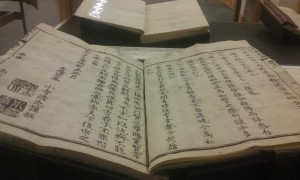
Today I went to see old books in Kroch Library. We were taken to the basement where all the ancient manuscripts were kept. The librarian first showed us the US constitution displayed at the entrance of the library. It was hard to believe that the piece of paper I was observing was actually signed by Abraham Lincoln and other famous political leaders of the time.
The librarian then took us to a small room where books of various ages were displayed on a table. He showed us ceramic tablets from thousands of years ago, first paper books that had wood covers, the original collection of William Shakespeare’s plays, the original books of Charlotte’s Web by E. B. White, and many others. One interesting thing I learned during the lecture was the sensitivity of books to light. Each time a book is exposed to light, the page becomes darker and the ink fades. Because of this natural phenomenon, these ancient books are stored in the dark. In one way, it felt like we were observing zombie books that have been buried for thousands (literally) of years.
After his presentation, we were free to look around at different ancient manuscripts in the Kroch ancient book museum (or whatever it is called). After seeing all these ancient manuscripts and books, it felt amazing to know that I (and all other Cornell students) have unlimited access to all these ancient treasures. I would definitely recommend checking it out!
national treasure: kroch library
Let me begin by admitting a sad, sad fact:
I haven’t read for fun in several years. Since high school, I’ve had so much required reading for school that I either haven’t had the time or was too tired to read for leisure. Going on the rare books tour, it was great to see Mr. Heidig’s excitement for his work. His clear passion for the study of these books and the history behind them brought me back to a time when I read far more often.
In my junior English class, we had to pick one author and read 4 of their novels, as well as complete other assignments for a year-long major author project. I picked Mark Twain, and I remember learning all about his childhood and adult life–including that he had spent 20 summers in Elmira. What I never connected until yesterday was that the Elmira of his history was the Elmira just 30 miles away from here.
It’s so fantastic that Cornell has a library and collection as fantastic as the Kroch library. I’ll definitely be visiting again in the future. Who knows, maybe I’ll even find time to read for fun again someday.
The Fascinating Rare Texts and Ancient Artifacts in the Kroch Library
Through the Rose Scholars Program we had the fantastic opportunity of learning about the Kroch Rare and Manuscript Library from Lance Heidig, an Olin librarian. He crafted a fascinating talk that highlighted several of the impressive artifacts from the Kroch library while telling an abbreviated story of the development of Western civilization from four thousand years ago to the twenty-first century. Some of the artifacts are pictured below.
However, what made this such a wonderful experience for me was learning that Cornell has a football field-sized vault in the bottom of Olin library that houses these special objects and primary sources. Mr. Heidig also did a great job of highlighting the need to balance preservation and access. While it is important to keep the objects and texts in good condition, it is equally (if not more) important that students, professors, and scholars can learn directly from them. Overall, I truly enjoyed learning about this fascinating aspect of Cornell that I previously did not even know existed!
The Wonder Within
This past week’s Rose-Becker cafe hosted Professor Drew Harvell. She discussed marine biology, and focused on the fragile ecosystem that is our choral reefs. We watched a short film called Fragile Legacy which lead us through the history of glass modelling of marine life and then her recent studies and travels. Glass modelling is a crucial aspect of the representation of marine life. Many animals have hardy bones or some better material that can be easily preserved so we can put them up in displays in museums, but that is not the case for many marine animals. Jellyfish for instance have very soft bodies, and if you were to preserve them in any chemical solution, it would just look like a big white blob. For that reason, glass is used in order to show the delicate nature of the organism and describe the way that it moves and flows. Some of these glass models will be presented within the Johnson Museum next year.
Another aspect of the documentary was discussing her travels, and the delicate nature of the coral reef ecosystem. The coral reefs and the wildlife within them are constantly being damaged. Some fisherman throw dynamite into the water to kill lots of fish and collect them and in the process are damaging the reefs beyond repair. There needs to be much more government sanctioning and regulation in order to preserve their delicate ecosystem. We wouldn’t want any more rare and exotic species to go extinct than there already have. We have such a beautiful world beneath our waters which still holds many mysteries. Let’s hope we don’t destroy them before we can find them.
Cemetery clean up
On Saturday I teamed up with some of my best friends from west campus to volunteer for Into the Streets. Our job was to help clean the cemetery and clear a path for the run that takes place there every year to raise awareness for the cemetery and its historical value, and to raise money for its upkeeping and restoration. While it was hard work, and my back and arms hurt for days, we definitely managed to have fun working together to better our community. And through the rain and the blisters it really put into perspective that things happen outside of the bubble we call Cornell University, and that our community could greatly benefit from our banding together more frequently to improve the community in which we live. Volunteering is always time well spent, even though it’s easy to say that we don’t volunteer because we’re too busy. I always feel really good after giving my time to a good cause. I hope more Cornell students, myself included, will be more involved in Ithaca in general–it’s so easy to forget that the outside world exists, and so easy to overlook the difference we could all make.
The Wonders of the Ocean
In this week’s cafe, we had a chance to watch a short film Fragile Legacy and explore the magnificent Ocean. The film started by introducing Leopold and Redolph Blaschka, two glass artisans that made glass models of marine life. I was truly amazed by how fine and delicate the glass models are, and their high resemblance to marine creatures. It must have taken huge amounts of effort to create these glass pieces, and their dedication and passion for both art and the ocean impress me a lot. It would be nice to see the glass for real some day and I’m happy to learn that they will be exhibited in the Johnson Museum next year.
Besides appreciating these glass pieces, we also learned about the environmental issues of the Ocean. Due to the rising concentration of carbon in the atmosphere, the Ocean is taking in more carbon dioxide and growing more acidic, which causes some organisms to have trouble growing shells. Some people’s dynamite fishing destroyed coral reef habitats. An epidemic broke out among starfishes, now causing the population of starfish to decrease dramatically. Just like the Blaschka collection, these species under the sea are all extremely precious and fragile. We don’t want to lose all these wonders of the Ocean, and it is important for us to be aware of the severeness of these ecological issues.
The Cornell-Ithaca Divide
Last Saturday, I volunteered for Into the Streets with a group of other Rose House residents. We went to the Greater Ithaca Activities Center and did some yard work there because the facilities employees who can only work limited hours are unable to tend to the outdoor areas. We finished the job pretty quickly as there were a lot of volunteers from Rose House and the space was fairly small. I enjoyed the experience and it’s important that we find ways to give back to the Ithaca community. As I spend most of my time on campus, I often feel very isolated from the town and I can’t help but think how, despite our proximity, we are very distant fro the Ithaca community. We have over 14,000 undergraduate students yet we do so little for the community we live in.
The GIAC is an incredibly important resource for families and children in the area. It provides tutoring for students as well as STEM programs. The GIAC receives funding from the city of Ithaca because of the need there is for its services in the community. The GIAC is committed to helping its students succeed and collaborates with the neighborhood schools to address student needs. In the past, Cornell students have received university funding to set up programs at the GIAC, but these programs no longer exist because of a lack of students willing to sustain and continue them throughout the years. If you are interested in helping out and giving back to the community, the GIAC accepts volunteers all year round.
A Walk Through Time
This Friday, we had the privilege of receiving an exclusive tour of Kroch Library. Prior to, I referenced Kroch as the pin-drop silent closet of Olin. Fortunately, I discovered the vast rarities that have been collected into a giant, football field-sized (actually) archive. Everything from a first-edition King James Bible, to handwritten letters from Mark Twain, to Buffalo Bill’s signature, to Fredrick Douglas’ The North Star, Kroch Library is a haven of primary sources and artifacts.
30,000 of the books that are a part of Kroch’s collection were contributed by, our very own, Andrew D. White. He was known as one of the best book collectors of his time. One of his conditions upon his donation to Cornell was the necessity of constructing a fireproof building for the books. Hence, Uris Library. The second condition was to make the books accessible to all students. I think this condition exemplifies the mission of Cornell University: an institution where “any person can find instruction in any study.” His collection used to be housed in the ‘Harry Potter’ library, but is now stored in a temperature-regulated vault under the Arts Quad, along with half a million other rarities. Fun fact: this vault is the most secure place on campus. After the tour, I started thinking about this vault. A football-field of physical history.
You could literally walk through time.
Pumpkin Carving as a Stressbuster
Last week I arrived at the Rose library ready to sit down for an hour and listen to some tips on living a healthy and happy life. When I walked in, however, I was pleasantly surprised to find that all of the tables were covered in pumpkins and carving tools. I quickly looked around to check if I was in the right place and, when I was assured I was, I found a seat alongside some fellow peers who seemed just as surprised as I was. Then, we all did some verbal brainstorming of carving ideas and hesitantly began carving (since many of us had not done so in a very long time).
Through the duration of the activity, I felt extremely relaxed and carefree. I could not remember a time this semester that I had not thought about work or upcoming exams. Like many Cornell students, I am so constantly bogged down by academic, social, and career pressures, that I often fail to step back and take my health and happiness into consideration. While many students cope well with pressure and effectively manage their time and responsibilities, many (like myself at times), often find it difficult to handle all of life’s many challenges at once–especially in a rigorous academic environment like Cornell. That being the case, it is extremely important that we take the time out of our schedules to step back and engage in activities like pumpkin carving, for they allow our minds and bodies a chance to rest and recuperate.
In the end, while this was not the event I was expecting to attend, I did walk away reminded of the value that fun, social activities can have for one’s health and happiness.
Happy early Halloween, everyone!
Ocean Glass
Last Wednesday, I had the chance to screen David Brown’s Film, Fragile Legacy centering around the work of Drew Harvell on her preservation of sea creatures and the sustainability of marine ecosystems. Our discussion initially started out with a little bit of a background on Blaschka glass pieces, which originated from Leopold Blaschka and Rudolf Blaschka, a father and son glassworkers who produced some of the most breathtaking and unimagenably detailed glass objects of marine life. They opened a new bridge between biodiversity and curious minds on land. They allowed direct access to ocean environment, which our co- founder Andrew Dickson White decided to take advantage off and authorized the purchase of 570 pieces of Blaschka models to be used for the purpose of teaching about marine biology. Today Drew Harvell, propagates the art of Blaschka glass models by finding living representatives in the ocean and restoring pieces which have been damaged over time.
We additionally touched upon other concerning issues that are endangering marine life, particularly sea stars. The cause of the disappearing of these creatures is a virus outbreak, which is unfortunately out of our control and a result of ecological changes.
Fragile as Glass
Drew Harvell’s discussion was very interesting, but not in the way I expected. I thought that I was attending a talk about the fragility of the ocean ecosystem and watching a movie that would show the negative effects of pollution and overfishing, which was definitely true, in a way. However, the movie and talk also focused on the Blaschka glass collection, a hidden gem at Cornell. The Blaschka figures are beautiful, hand made, glass models of marine creatures. I was awed by the detail on the creatures, and impressed by their resemblance to the living organisms. I especially liked that the Blaschka’s included small organisms that are typically thought of as less important.
Another interesting part of the discussion that I was surprised by was that sea stars are such an important part of the ocean. I had no idea that stars really did anything at all useful, but during the talk I learned that they are considered a keystone species, because they keep the urchin populations under control. So it is very worrying that the stars are being hit so hard by a disease that, though humans may not have caused it, our actions are exacerbating it (rising ocean temperates makes the stars die quicker).
Professor Harvell said that the glass models will be on display at the Johnson at the end of the year, which is an exhibit that, I at least, look forward to seeing.
Drew Harvell Glass Collection
The documentary shown last night was amazing. I can not believe I did not know that Cornell has the largest glass collection right here on campus. I was stunned by the level of detail in each piece shown in the documentary and how closely they resembled the real organisms. This documentary captured the unique diversity in the oceans around the world that most people do not know about. I thought it was great that Dr. Harvell along with her team traveled around the globe to find these organisms and document them underwater.
The art of glass blowing itself was unbelievable. Some of the pieces were so delicate yet extremely detailed. Leopold Blaschka and Rudolph Blaschka are the greatest glass blowers of all time. They created this extravagant collection to capture the details of these specimen so that they could be displayed and observed. In many cases they were used as teaching tools so that students could examine the details of each piece and understand how each organism differed biologically from one another. This was incredibly important because specimen such as jellyfish do not preserve well therefore the only way to show their structure and movements was to model them using glass.
They also produced a flower glass collection which is displayed at Harvard. It is a shame that through the years many of the pieces have been damaged however there are restoration efforts underway to preserve the pieces back to their original form. It is important for the restorers to know the original kind of materials that were used to create the pieces such as paint in order to make them the same as the originals.
An Unconventional Time Capsule
Going into the Becker-Rose Cafe yesterday, I thought the talk was going to be solely about marine ecosystems and preserving them, but I was pleasantly surprised to find out that Professor Drew Harvell had a lot more in store. She was also there to tell us about the beautiful glass replicas of various underwater organisms that different artists and biologists alike create. Showing us gorgeous pictures of insanely intricate glass models of jellyfish, octopi, sea anemone, and coral—all with vibrant colors and intense detail—Professor Harvell explained to us that these models, specifically those made centuries ago, reveal the change that has occurred in these animal species over time. In other words, because the glass animals capture the physical structure of these animals almost perfectly, marine biologists today can use them to examine how those animals have evolved into what they are in the present time. In this way, Professor Harvell described these highly-detailed objects as being a sort of time capsule to represent the dynamism of different underwater creatures.
Something I found myself wondering as she said this was: “Why don’t students studying the lives, structures, and functions of these organisms just observe ones that have been preserved over time?” And Dr. Harvell had the perfect answer for this: When a jellyfish, for instance, has been preserved in formaldehyde, the animal’s body turns an unappealing gray color and gains an exceptionally hard feel to it, something that doesn’t accurately represent the organism’s features in the slightest. Knowing this, it makes sense why such beautiful models are used for educative purposes instead.
Finally, as Dr. Harvell was wrapping up her talk, she emphasized that we can’t afford to take our oceans and their inhabitants for granted because we only have one earth and these amazing creatures will have no where to go if their homes are continuously destroyed.
The Blaschka Models: Art and Science
It is always intriguing to discover different areas where liberal arts and science intersect and Professor Drew Harvell’s discussion and film, Fragile Legacy, about the Blaschkas’ glass models of marine life was no exception. Learning about the Blaschka models was really a unique experience for me as they were not really like anything I had seen before. While I had seen plenty of detailed paintings and sketches done of wildlife, I had never encountered a collection that had such a focus on exotic forms of marine life, all done in the form of delicate glass models. Considering also the degree of size of the collection, it was a remarkable achievement. What really struck me about the artwork was both how very unique the collection is in my opinion and how difficult it must have been to create something like that in the nineteenth century. Not only did the Blaschkas have to assemble these complex pieces from glass alone with the technology of that era, but also they must have spent a considerable amount of time and effort actually searching for the creatures and diagramming them in detail. Furthermore, when the film explained that the search to find many of the creatures depicted by the Blaschkas is ongoing, I was only more impressed with what already seemed like a herculean feat by the Blaschkas. The fact that we have not confirmed sightings of these creatures yet, while the Blaschkas were able to find them in the 1800’s without any advanced scuba diving equipment is astonishing. From my perspective, another incredible aspect of the story was that Cornell holds the biggest collection of these glass models in the world, commissioned by our first President, but after the early 1900’s they were forgotten about until relatively recently. Now that these incredible works of art are being rediscovered however, it seems that they have inspired people to seek out and protect some of the sea creatures that were common only 200 years ago and now appear to be rare or gone. Overall, learning about these glass models was a real pleasure and as the professor said, the magnificence of invertebrate creatures can only truly be captured with glass models and I look forward to appreciating that when they are put on display in the Johnson Museum.
A Sea of Glass
Last night’s Cafe was unexpectedly fascinating. Drew Harvell spoke about the marine environment, but approached it not from the expected negative images of overfishing, pollution, and increases of coastal population. She focused on the bizarre forms and colors of marine life, and shared her passion of the intriguing life forms in the ocean. A tool that has been used to truly capture the intricate ocean life forms, is the Blaschka glass collection. The majority of the talk consisted of a screening of the short documentary, Fragile Legacy, which outlines the Blaschka art and how the glass acts as a time capsule to compare the ocean from the 1860s, when the glass was created and the current ocean environment. It is an incredible film, and is currently a finalist in five film festivals.
What truly fascinated me was the glass itself. My father is a glass blower at the Corning Museum of Glass, and we have a glass studio at my home, therefore I am quite familiar with the process of lamp working and glass blowing, and how difficult creating this art form can be.
What influenced Leopold Blaschka and Rudolph Blaschka to take on this intricate challenge of creating some of the most talented glass pieces to date was the ways of exhibiting delicate specimen. Displays of stuffed and mounted wolves, bears, and birds posed in life-like positions were fairly easy to achieve, but exhibiting delicate specimens such as flowers or sea invertebrates posed a distinct challenge. Botanical specimens could be pressed and dried, creating a flatter, less colorful version of the original plant, but invertebrates had to be preserved in jars of alcohol, which faded the colors and caused the bodies to gradually collapse. Neither option was terribly inspiring for the public and certainly made the scholarly study of the specimens more difficult.
They made thousands of intricately worked, carefully detailed glass models of invertebrates and botanical specimens for the use of teaching aids and in exhibits, including the famous collection of glass flowers at Harvard University. What truly amazes me is how accurately and finely they captured every detail. They did this so well, that Drew Harvell took on the challenge of identifying marine life from these glass pieces.
It is truly saddening that throughout the years many of these pieces were broken in storage, but through the work of restoration, some of these pieces will be able to be appreciated once again.
The Blaschka Models
During the October 28th Rose Scholar lecture, Professor Drew Harvell introduced Cornell’s collection of Blaschka invertebrate models. The Blaschka models, made in the 19th century by glass artists Leopold and Rudolf Blaschka, capture the biodiversity of oceanic creatures of the time period. Professor Harvell explained that the models accurately portray the color, size, and shape of the invertebrates, and thus, give her a window into how form follows function in each part of these organisms. Not surprisingly,climate change and over-fishing have contributed to the ocean’s continual decrease in biodiversity; in fact, it is possible that several of the invertebrates in the Blaschka collection are already extinct. One example is the octopus vulgaris, which scientists can no longer find in their dives off of the Mediterranean coast. Coincidentally, in one of my biology classes this week, we discussed climate change and shrinking biodiversity. Most of my classmates associated climate change with animals on land. By learning about the Blaschka collection, I most certainly have a fuller appreciation for how greatly the ocean and its creatures are also affected by climate change.
Into the Streets We Went
A day dedicated to community service by the community is a great idea. Because we’re all living in the same area, local townspeople and students alike, a large effort to help each other definitely bolsters community morale and strength. Last Saturday, as a group of about 10 people, we traveled to the Greater Ithaca Activities Center. Our goal was to rake, sweep, and discard fallen leaves as well as pull up masses of overgrown weeds from around the main building. Given that the rakes and brooms were in limited supply, these tasks had to be completed by hand (with garden gloves) by the majority. The more physical aspect of these tasks made the work itself more enjoyable as we were able to get up close and personal with the leaves and weeds. Being an Environmental and Sustainability Sciences major, I particularly enjoyed the fact that I was immersed in a more natural environment and able to spend a few hours helping a good cause simply by being outdoors. If we had had more time, I would have liked to stay longer and possibly help inside the building as well.
Knowing that the Greater Ithaca Activities Center is dedicated to providing a a large variety of fun and engaging activities to kids of all ages and backgrounds in the community made the service I did extremely worthwhile. Not only do they host children after school, but they also put together different sports teams, offer tutoring services, and organize unique events related to science or Halloween. After this experience last Saturday, as soon as I can figure out reliable transportation, I would like to volunteer on a regular basis with them doing whatever I can to further their mission of improving the lives of the youth living in greater Ithaca.
The Fragile Sea
The topic of last night’s Cafe was as intriguing as it was unexpected. Thinking that I was going to hear about the conservation of the marine environment, I was surprised when we were introduced to the beautiful glass art pieces that were made to imitate the ornate intricacies of their living counterparts. The majority of the talk consisted of a screening of the short documentary, Fragile Legacy, which outlines the art’s history and impact it’s currently making in the world.
The glass art, depicting all sorts of marine invertebrates such as flatworms, jellyfish, starfish, and octopuses, dates back early in Cornell’s history to when A.D. White purchased a large number of these sculptures for the use in instructing marine biology. Since then, the art was long forgotten and stored away until Professor Harvell discovered the collection and revitalized it. Harvell talked about her work restoring the art, as well as using it as a tool to draw attention to changing ecosystems of the real world which the art is meant to portray. This project evolved into the making of a film that documents the species represented by the glass pieces. It was fascinating to see how Harvell traveled around the world, from Hawaii to Indonesia, to dive at the few locations where certain species still exist.
Particularly interesting was the story of the starfish that have been dying out rapidly along the west coast of the U.S. since 2013. I remember reading many articles about this tragedy, as thousands of star fish were mysteriously dying and washing up on shore. As a keystone species, the starfish death is especially devastating to the balance of the underwater ecosystem. It was interesting to realize that it was a Cornell professor who identified the virus that is causing this massive devastation ranging from Alaska to Mexico. Unfortunately, according to Harvell, there is nothing to be done. The last two years have brought a worsening of the virus as it has now spread to China, and most recently, Australia. It’s depressing to think about the damage we are unintentionally inflicting upon the balance of the natural world, even down to the smallest marine invertebrates. Although it was gratifying to follow-up with a story I had read about two years ago and hear first-hand about the research being done, it was discouraging to learn that there is no strategy in place for dealing with such misfortunes. I hope that Harvell’s work, both in showcasing the glass art and creating a film about conserving the marine environment, as well as the efforts of others, will have some impact in saving that which deserves to be protected.
Mr. Marshall Curry
Dinner with Marshall Curry was a spectacular event, filled with his anecdote on how he came to where he is today. He seemed to have discovered his love for filmmaking accidentally, with no real clear path of what he wanted to become in life or what he wanted to do after college. After his first film, Street Fight, which took him many trials and errors, for which got nominated for an Academy Award, he continued his newfound love of making documentaries. His large variety in films is credited to the fact that his ideas come to him and his opportunities to film comes randomly. He said that his film on the Earth Liberation Front came to him when his wife had told him that someone from her workplace had been arrested for terrorism, and when he heard it the first thing he wanted to do was make a film on it.
Having dinner with someone so accomplished, yet so humble, inspired me to look at life more calmly and let opportunities come to me. It made me learn not to freak out over small things that happen and to work hard to get to where I want.
The Vast Power of a Political Machine
A week after I saw the film Street Fight directed by Marshall Curry I still sit here astonished that incumbent Sharpe James won the election against Cory Booker. This movie certainrly spoke to the power of the political machine, and brought to reality the tactics of intimidation that seem unreal unless they are seen. Through the examination of both political campaigns, the construction of a city government and its weaknesses are brought to the forefront.
Booker seemed extremely committed to reaching out to the community and being present in order to experience in the issues and understand how to remedy them. I think that it was interesting to see the things that fear of losing led Sharpe James to do. He spent a lot of time on camera telling blatant lies. After seeing this film I wondered how widespread this issue is among the city governments in the United States. Marshall Curry mentioned that he received a lot of letters saying that people all around the world claim to have experienced very similar stories surrounding their local governments.
In documenting this long, suspenseful race, Curry captured a story that was suspenseful, and exposed the staying power of the political machine.
Glass Art Prompting Marine Conservation
This evening I was able to hear Drew Harvell speak about her work with Blashka glass, some of the most intricate and accurate glass models of marine life. Based on what she said and the video that we watched, I learned that these glass sculpture serve much more than art in her work. These sculptures serve are real life models of marine organisms, as they are incredibly accurate. They are used for instruction purposes and to study the lives of marine creatures.
After watching the video Drew showed, I also learned that these sculptures have made an even greater societal impact, even more than helping to educate people. These sculptures have helped scientists and marine biologists, including Drew herself, to explore the depths of the ocean. These sculptures helped provide Drew models of what to look for and explore in the ocean. And in fact, due to these models and knowing that the organisms Blashka constructed existed during his time, we now know that organisms that are now no longer highly populated must have become endangered. Thus, the interest the the Blashka glass sculptures prompted led peoples’ interest to explore the ocean. And this interest fueled more attention being directed toward the ocean and marine life. As a result, people have noticed harm being brought to marine life and have called for action.
I never would’ve guessed that the strong call for marine conservation and that exists today would be partially attributed to glass sculptures created many years ago. Art and science have found a very important intersection.
Glass life
So many of these cafes center on increasing awareness about environmental sustainability. I like how Drew Harvell’s talk was focused on the beauty of nature and its fragility, rather than the negative aspects of what humans have done. Her movie was filled with breath-taking shots of marine life, and seeing the real organisms compared to the Blaschka glass pieces was remarkable. I remember seeing glass blowing at the Corning Museum of Glass, but I can’t imagine how this family created such fine details in their works.
I’m curious about how Harvell has attempted to find all the matches of the glass pieces to the real organisms in the ocean. How much have the species changed since the 1860s? Is there any way to create a checklist? While I find her job diving in the reefs fascinating, I wonder if this kind of research is too intrusive on the organisms. I’m sure other people are doing worse things, but is it unethical to chase these beings just to document their existence?
This Blaschka collection also makes me wonder what other goodies Cornell has collecting dust in a box somewhere. I cannot wait to see the display at the Johnson Art Museum, and I hope to revisit the Corning Museum once more, to see what glass artists have done in comparison to these beauties.
A story about the ELF; no, not a charming Christmas story
Unfortunately, I have to start this post with a disclaimer; I, in no way, support the actions of the Earth Liberation Front (ELF). Marshall Curry did such a fantastic job capturing the complexities of Daniel McGowan’s situation, however, that I must concede that the morality of the events is not black and white. One of the most intriguing parts of the film was when McGowan reflects on the last action before the group dissolved. When McGowan discusses his unhappiness with the events that occurred at the University of Washington and northern Oregon, the audience gets a glimpse of the internal conflict that he must have encountered at the time. This exclamation of guilt and remorse does not justify the previous actions, but it is just one example of the complexities of this ELF story. It was really interesting to see the individuals on the side of the law reflect on their questioning of morals and motives after living through the story. I truly enjoyed this film and I am glad I had the opportunity to listen to Marshall Curry’s discussion after the screening.
Also–as a side note–it was really strange to think that both McGowan and representatives of the legal/prosecuting side both enjoyed this film.
Marine Beauties
Tonight at the Backer-Rose Cafe Professor Drew Harvell came to speak to us about the creatures of the ocean and to screen the short film “Fragile Legacy.” This documentary, which Professor Harvell is a part of, is quite eye-opening in terms of the variety and beauty of creatures that call the corals of the oceans and seas their homes. The idea to create this movie actuated stemmed from glass models of sea creatures. In the 1800s the glassmaker Leopold Blaschka took a trans-Atlantic voyage. During this trip he encountered an astounding variety of sea life that he later on modeled in glass – incorporating even the most minute details into his sculptures. This beautiful project – which demonstrates the power, beauty, and potential of the fusion of art and science – was used as a teaching tool here at Cornell University during the school’s early years.
In the present day, Professor Harvell’s (and others’ ) undertaking of the project to restore the glass models gave rise to adventures around the world and dives in places such as Indonesia and Hawaii. The purpose of these trips was to try to see if the species that were alive in the 1800s are still thriving today. “Fragile Legacy” shows footage of various types of octopuses, sea stars, jellyfish, sea anemone, cuttlefish, and more – creatures of every possible shape, color and appearance. However, there used to be an even greater variety – as indicated by the fact that biologists such as Harvell cannot find real life matches to some of the Blaschka models. Thus, her work and this film carry an important message: marine life is beautiful, but once it is endangered there is little we can do to help. We must act to preserve and protect the Earth and its gamut of creatures. If we don’t, we will loose something that is not only beautiful but also crucial to the health of our oceans.
Art in Nature
When I heard we were watching a movie I could not help but be excited. It was like when your teacher wheels in a TV in class. This was way better though. Drew Harvell started off the meeting by showing several comparisons of glass pieces with their photographs of their real life invertebrate counter parts. They were some of the most impressive works of art I have ever seen. They were so life-like, colorful, and detailed. I could not believe that such amazing pieces had been left in storage for so long, broken, and forgotten.
They were better than any model I had ever seen. Thats when the film started. Fragile Legacy was a stunning visual to watch. I was in awe at some of the creatures they filmed, creatures whose movements and colors were captured in the glass pieces representing them. Most models are stiff and focused on detail instead of matching what the animals look and feel like so it was impressive to see how the glass captured both the detail and fluidity of these invertabrate marine animals. Also of interest was the history behind the creations and the skill that the blaschka family passed on through the generations. 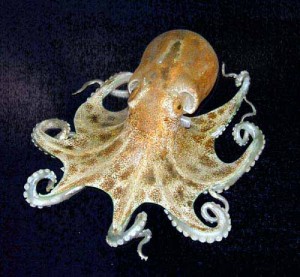
The purpose of the film was that Professor Harvell and her team were searching for the living animals that the glass represented to see if they were still around or if they had gone extinct. It was interesting to hear that there is no checklist for invertebrate marine life considering they are a huge component of the marine ecosystem. This made her task impossible as she would never truly be able to know if they had gone extinct or were still out there. Overall it was incredibly impressive to see the comparison between the beautiful glass pieces and their living models.
Marshall Curry’s ‘If a Tree Falls’
Last week I saw the award winning documentary “If a Tree Falls.” This film, directed by Marshall Curry, tells the story of the activist group ELF, or Earth Liberation Front and their means of protesting. The story follows one of the members of ELF and his awaiting his trial. By doing this, the audience is able to see not only what happened, but also how it is being handled in the present situation. Throughout the whole film, suspense is building as it gets closer and closer to the day of his trial and his punishment will be decided. By doing this, the audience can see the side of the cops as well who are working on the trial. While it would have been easy to focus on one side of the story, Curry brought in members of both sides as well as locals to the area to discuss exactly what was going on. Showing both sides leaves more room for questions.
One major issue in the film was the idea of whether or not the group should be called a terrorist group. While I can understand where the government could see this as being terrorism, I was shocked that this was even a relative question. To me, it only seemed to be that they were trying to fight for what they thought was right. They had learned from years of peaceful protest that that would not get the attention they needed. Although they maybe did not approach it the best possible way, both sides are understandable.
One vivid scene I remember was towards the end of the movie. There was a shot of a forest on a mountain and there were just sides of the forest gone. This image really caught my attention when I realized exactly what these people were fighting for. I really enjoyed this documentary because I learned so much from it. I thought it was very interesting how it showed both the sides of the story and allowed us to make our own decisions and opinions on the issue. I also liked how the story followed a specific person who was in the group and his journey through this time.
If a Tree Falls
The documentary If a Tree Falls: A Story of the Earth Liberation Front follows the story of Daniel McGowan, a man accused and eventually convicted of several large arson attacks. Mr. McGowan and the other members of the extremist environmental group called the Earth Liberation Front set fire to businesses which they thought were harmful to the environment. Mr. McGowan and his accomplices deliberately did not kill or injure anyone. They were only interested in destroying property.
My main takeaway from the documentary was the issues with using violence in an attempt to bring about social change. Instead of focusing attention onto the issues and promoting change, the violent actions of the criminals focused attention onto themselves. While the documentary touched upon relevant environmental issues its principle focus was issues of criminal law and Mr. McGowan’s legal defense. Unlike other environmental documentaries I have watched, this documentary did not move or motivate me to learn more about environmental issues. Instead, it left me more interested in the interpretation of criminal law in this case. To me, this shows that the actions of the criminals were not effective at accomplishing their goals.
Also interesting is the choice by Mr. McGowan and his accomplices of using fire to promote environmental issues. Large fires like the ones shown in the documentary are harmful to the environment and release pollutants into the atmosphere. Additionally, by burning down structures that would be rebuild, the group only increased demand for lumber. Based on my recollection of the documentary none of the victimized businesses where permanently shut down further showing the ineffectiveness of using arson to promote social change.
I believe that the group would have been more effective by using the political process. Given the large demonstrations happening there was clearly fairly widespread support among citizens for environmental reforms. If efforts were focused on political reforms it is possible that results would have been achieved.
An afternoon at GIAC
This past Saturday I participated in Into the Streets. My group volunteered with the Greater Ithaca Activities Center, raking and weeding the garden. The day was a little rainy for it (luckily we narrowly missed showers before and after our time there) and we were a little short on rakes, but overall I really enjoyed the afternoon. After we finished working, a director at the center explained to us that the everyday maintenance tasks we’d been doing were sometimes neglected at the center because they have a limited staff and other duties, like keeping the inside of the center clean, take priority. I am glad that we were able to meet a need at the center and contribute, in that small way, to the operation they are running.
I also learned a little bit about the programming that the GIAC runs – they have tutoring and mentoring programs for local kids, and a longstanding boxing program that has produced noteworthy boxers in the past. It’s great to see the center providing these services to the Ithaca community. It’s one way that people can come together and get to know and support one another. That closeness and support ties communities together. I’m grateful for Into the Streets for providing us with a way to take part in the greater Ithaca community, even if this time it was just for the afternoon. I hope there are many more afternoons to come.
Are any Means Justified?
Last week, I attended Marshall Curry’s screening of “If a Tree Falls” at the Cornell Cinema. I had not been to the cinema before and this was a great first experience. The documentary asked more questions than it answered about whether eco-terrorism fulfills a need in our apathetic society. The film focused on the ELF, Earth Liberation Front, which recognized that peaceful protests about the environment were not effective or getting the recognition that they deserved so began to engage in eco-terrorism, burning wood companies, greenhouses believed to hold genetically modified plants, and many more.
The documentary shows the audience how the EFL was born out of desperation and also police brutality. Peaceful protesters sitting in tress to prevent them from being cut down would be violently harmed by the police to get them down. Police would cut their pants and pepper spray them, they would put pepper spray on q-tips and stick them in their eyes, they would violently beat peaceful protestors. This created a convincing argument for ELF’s inception.
Although there were times that the ELF seemed justified because they did not directly hurt any people, they still wreaked havoc and made countless people feel unsafe. The owner of a tree cutting company talked of the fear he felt after their plant was destroyed, about the alarm systems he and his sons installed in their homes. Terrorism can occur even if people are not hurt. Eco-terrorism, although it does not inculcate the same fear and repulsion in us as domestic terrorism, is just as costly. Additionally, the audience was made to question if ELF was always justified in what they destroyed. The tree cutting company would plant six trees for every one that they cut. Curry left it to the audience to decide if that justifies the destruction of forests.
Many of the past Becker-Rose cafés that I have attended have focused on the environment and what we as individuals and as a society should do to help save it, how we can get people to care, and what options there are. This film further complicated the issue, asking if any means are justified in creating the awareness that is so critical to the campaign against global warming.
Into the streets
This weekend, I participated in Into the Streets for the first time. The team from Flora Rose went down to GIAC to do some yard work for them. I did some raking of leaves and some pulling of weeds.
GIAC is a great organization in downtown Ithaca that I didn’t know about before. I think it’s great what they bring to the community, and I was happy to be able to do some volunteer work for them. I think it’s great to be able to get down into downtown Ithaca and do a good deed, and I thought it was great that I was able to do that with Rose house.
If a tree falls…soon the whole forest has fallen
Last Wednesday I watched Marshall Curry’s documentary If a Tree Falls. I went in not knowing anything about the movie and it immediately grabbed my attention. It was very well done and painted a problematic picture of how nature is treated by big corporations only looking to maximize their profit. While I have known in the back of my head for a long time that fighting for nature’s right is hard and complicated, I honestly had no idea just how bad it could be. In the movie, it is shown how policemen torture peaceful demonstrators by spraying pepper spray right into their eyes. The measures that both the police and some of the corporations shown in the movie took were completely out of line, and as I watched I could only imagine the intense frustration that must have built up in people like Daniel McGowan.
But then at the same time, you are constantly reminded of just how extreme the Earth Liberation Front’s response really was. Burning down buildings is illegal for good reason and as a viewer you get a look into the devastation that the owners of one fabric in particular felt. And that is why the movie was so gripping, there was no clear right or wrong in the individual people shown, just people who got stuck on different sides of an argument; and argument about the Earth which is possibly the most important argument we have to think about in these days. Interestingly, toward the end of the movie, both the Earth Liberation Front as well as the police hunting them down concluded that they could understand somewhat why the other side had acted the way they did.
At the end, Marshall Curry held a question and answer session where we learnt more about the process about making the movie. He told us that he is fascinated by contrast, specifically where your imagination doesn’t agree with reality. And that is why he wanted to make this documentary in the first place, because he knew Daniel McGowan and he also knew that his idea of a terrorist was nothing like Daniel. And that was what shocked me as well at the beginning of the documentary, how such a nice man could get caught up in such crimes and labeled a terrorist. But at the end of the movie, I no longer felt as surprised that he acted the way he did, because while it is far from the way I myself would have wanted to act, I could see that he did what he truly thought was right.
What is Eco-Terrorism?
Last Wednesday I had the chance to attend the documentary screening of If a Tree Falls at the Cornell Cinema with Q & A afterward with the director, Marshall Curry. Before watching the movie, I read a brief description and was surprised to find out it was about the ELF (Earth Liberation Front). Which… I knew nothing about other than hearing the name before. So going in, I wasn’t really sure what to expect.
As I was watching the film, the experience was kind of surreal because while I knew things like this were going on when I was younger, I had absolutely no exposure to it. That being said, I feel like I learned a lot from this film.
One phrase they mentioned a lot in the film was eco-terrorism. The film raised a lot of questions for what exactly should be defined as eco-terrorism, or if the term should even be used. I think it is important that this question be answered, since it affects how people who participate in these crimes are classified. For example, one of the subjects in the film, participated in some of the ELF activities, including setting fire to private property. Even though he did not harm any people he was classified as a terrorist, and had to spend his jail time in a special facility.
Typically when I think of a terrorist act, I think of something that causes terror to people. Which his acts certainly did. However, some people say that an act is only a terrorist act if it causes harm to people. Since this is up in the air, I think we need to define what exactly is a terrorist act, and probably add different classes of acts instead of simply saying a terrorist act is a terrorist act. Since the main subject was classified as a terrorist, he was placed in a facility in that handles them. But he (who never harmed any people/ has no intent to) was placed amongst many many others who do want to harm people and have done horrible things to humans.
So was it fair? Should he have been classified as a terrorist for the rest of his life? Even though he only damaged property?
What is Environmental Terrorism?
Last week Wednesday, I attended the Rose Café event featuring guest movie director and producer Marshall Curry. Unlike previous Rose Café events, which took place in the Rose library, this event took place at the Cornell Cinema. At the cinema, Curry screened for us his movie If a Tree Falls. The movie was a documentary, which centers on Daniel McGowan and his involvement as a member of the Earth Liberation Front movement. The documentary covers the time from Daniel’s first finding out about the ELF to his eventual arrest.
Overall, I really enjoyed this Rose Café. One of the best parts of the Café was going to the Cornell Cinema for the first time. I know it is sad that I am a junior and have never set foot inside the Cornell cinema before, but it was a great, first time experience. If it were not for the Rose Café, I probably would have never gone to the Cornell Cinema and now, after having seen a film in it, I am excited to going to more movies in the future.
In addition to enjoying my first experience at the Cornell Cinema, I found the movie quite enjoyable as well. Going in, I knew what the movie was going to be about, but I had never seen the movie before. It was interesting to see Curry emphasize that cases like that of Daniel McGowan’s is not as black and white as one may think, especially when it comes to deeming his actions as “terrorism.” The concept of terrorism was intensely analyzed in this movie as Daniel and his ELF associates felt that because they took great precautions to not do any physical harm to anyone, they did not see their actions as terrorism. Personally, I feel that terrorism is not defined by physical harm and thus their actions can be classified as terrorism, but everyone is entitled to their own opinion. There obviously is no right or wrong answer as this topic is a very grey area, just as Curry portrays in his film.
Once again, I highly enjoyed this Rose Café event and I am looking forward to more events of this type in the future.
Helping the Ithaca Community
This past Saturday I participated in the Into the Streets Event and helped racking and clearing the yards for the Greater Ithaca Activities Center. My biggest motivation for this event was to have the time to do service in the community for Ithaca. In high school and even in my club GlobeMed at Cornell, community service was emphasized as a way to understand the community better which surprisingly being a student in the town, I do not know much about it.
The nice thing that the GRFs did were that they asked the secretary at the Center to explain what the center did. It was very touching to see the programs that were created to establish a stable source of knowledge and help for the youths that really need help in Ithaca. It is nice to think that our work of cleaning yards would be going to having kids coming in the next week and seeing a better kept facility outside. Even though it was hard labor, it was worth doing it for the kids at the youth programs.
Also, I enjoyed my time in the service activity making some new friends and learning more about people living at Rose this year and for next year!
Learning about the Inspiration behind Marshall Curry
This dinner was an insightful time in my Rose Scholar experience. It was my first time in having dinner with a guest speaker for the Rose Scholars. It was great to see the personal story of what it took for him to be where he is. I always find those type of discovery stories encouraging and adding to my dream to become a prominent scientist in the world. It amazed me in how much hard work he took to get to his position as an award winning director of documentaries and how technology history had shaped his career as well.
Mr. Curry had started at a small working in a radio station and realized over time that he was interested in making a story of sorts and wished to put the skills he gained to take a documentary. His most important documentary was made on an election that had powerful characters and made the documentary successful. Mr. Curry had shared that he had filmed his documentary with a small camera and no other fancy equipment. He thought that his film would be shown to his family and few friends but never imagined it being shown at a prominent film festival. His passion for documentaries had no expectations for rewards and it was more like they followed him.
I have seen some documentaries and like it how the stories are real in that every emotion you feel as the viewer is more or less the emotions captured in the character at the time. Documentaries take an unique angle on giving the honest stories of people in their adventures. This was almost the same thoughts that Mr. Curry supported in his talk over dinner and could be seen in his documentary that he is working on a guy who traveled to find his manhood.
If a Building Burns Down Near the Forest and Nobody’s Inside It, Is It an Act of Domestic Terrorism?
Radical groups aren’t the easiest to portray on film. If the filmmaker is too critical, the movie feels like a feature length “tsk tsk”. Saying “they had the right idea, but I don’t approve of their methods” typically doesn’t serve well as a call to action; if anything it only supports the status quo by quelling enthusiasm for a cause. Of course, a highly sympathetic portrayal bereft of critique will likely alienate moderate audiences, who will be so repulsed by the illegal actions and/or harsh views of the subjects that they won’t even stop to consider whether a valid point is being made. Plus, some members of the audience could be inspired to emulate the subjects and go burn down a garage. Unless your goal is agitprop, this is not a good result.
So I was impressed by how well Marshall Curry was able to toe the line between condemnation and sympathy. Really, the Earth Liberation Front members themselves seem to say it best; after all, they’ve had first hand experience. Perhaps the most memorable moment was when Curry starts interviewing ex-ELF Suzanne Savoie: she says something to the effect of “Oh, you wanted to talk about that” with the same tone one would use when asked about a ridiculously embarrassing thing you did in high school. There’s shame, but not to a psychologically debilitating degree.
The ELF members interviewed take full responsibility for their actions. Sometimes they only seem to half-regret their involvement. The destruction of a horse slaughterhouse is talked of as a righteous action (Curry’s portrayal of said incident suggests agreement). But when they talk of a case where an innocent farm had property burned and defaced due to poor intel, members recognize that they may have gotten in over their heads. Looking back, Savoie says she can find no way to justify that episode. By taking testimony from the perpetrators themselves, Curry is able to both capture the enthusiasm and reasoning behind political radicalism without condoning it. That he includes less radical environmentalist acquaintances of ELF and the arson victims in his documentary is icing on the cake.
Dinners and Documentaries
Dinner with a a two-time Academy Award-nominated American documentary director, producer, cinematographer and editor? Why not.
I honestly can say, besides editing and making silly middle school videos on iMovie, film is not something I am very familiar with. However, I am a lover of all documentaries and whenever I need a break from some intense Organic Chemistry, I turn to Netflix and find an interesting documentary. That is why when I found out Marshall Curry was coming for dinner, I decided to get an inside look into the documentary-making process.
Curry said something that I greatly identified with, “I thought that documentaries were something that other people made. Something that I would never be able to experience”. He explained with how he started filming If a Tree Falls, a co-worker of his wife was arrested for terrorism and he thought it would be something interesting to film. Just like that, he become that “person who made documentaries” that seemed so distant and unrealistic.
What makes documentaries so interesting to me, is that it highlights realistic scenarios in life. Movies often glamorize and exaggerate life scenarios and spin them the way they would like (If you watch Narcos on Netflix your frustrations could align with mine). However, documentaries are raw footage that highlight interesting people in the world we live in.
Curry has a wide range of documentary topics, from following a politician’s road to becoming mayor to following (one of my favorite bands) The National around. I never thought about how much work goes into editing and making a documentary, and sitting down with one of the top directors in the game was definitely an experience I won’t forget.
Daniella
A reiteration of Cory Booker
Last week I had the pleasure to watch a screening of Street Fight by Marshall Curry. I was so excited to watch this documentary because I have been keeping tabs on Cory Booker since middle school. I thought I know almost everything about his public life, but I failed to realize that Booker lost the first time he ran for mayor of Newark and the significance of that election. I’m telling you I thought I knew everything from his time at Stanford, Yale, and even the fact that he dated Oprah’s best friend, Gayle King. All I knew was that Booker is a polarizing political figure, and at one point he was mayor of Newark, and that he could potentially run for president in the distant future.
The documentary revealed the vices of the American political system on a local scale. It even looked in to the social dynamics of Newark and how that impacted the election. Booker’s opponent Sly James grew up in the poor side of Newark and had been in public office since the 1970’s, whereas Booker grew up in the suburbs went to an ivy league school and had no experience in office. It seemed like the first time Booker ran for office the people of Newark did not think that he cared about the city, it was as if he was not the real deal. Booker was so passionate about making changes for the city. In my opinion Booker did a lot to prove that he was committed to making a better Newark by living in public housing, going door to door to meet voters, and by connecting to voters on a genuine level.
It was such a pleasure to have Marshall Curry himself there to answer questions afterwards. I remember asking him a specific question along the lines of how did the Newark election parallel that of Bill de Blasio’s tale of two cities? For some reason toward the end of this documentary all I could think of was Bill de Blasio’s election and his tale of two cities slogan. Curry eloquently explained the distant parallels and the obvious differences. The whole experience was refreshing. All in all I really enjoy watching documentaries in order to fulfill my weekly requirement.
Nobody’s right if everybody’s wrong
Marshall Curry’s “If a Tree Falls: A Story of the Earth Liberation Front” makes me want to watch more documentaries. He told a fascinating story that exposed people on both sides of the issue and humanized them past their stereotyped roles. I enjoyed the little details, like how Daniel took off and recycled all the labels of his sister’s canned goods, leaving her clueless as to what is in each can. That kind of passionate action with little forethought weakened his cause, especially when a parallel is seen with the destroyed farm that did not have genetically modified plants. Yet the shot of the train with the ostentatious rows of harvested logs passing by in an endless display made me sympathize with his frustration.
At first, I thought it was ridiculous to call him a terrorist. He did not kill anyone. He wanted to see change happen, the kind of change peaceful protests did not seem to be making. But he is still a criminal. While I thought the shots of the company owner walking around his destroyed building looking sad were slightly corny and fake, that man and his family and other workers experienced terror, fear for their lives. He inspired terror, but the word terrorist may carry too much weight.
Something Necessary
It was dreary outside. The temperature dropped 10 degrees, it was half sprinkling with odd bursts of wind and the sky was a hazy gray. It didn’t seem like a good day to spend a few hours outside raking leaves.
But the thing is, you don’t do community service because it’s easy or convenient, you do it because it’s necessary. Granted, our job wasn’t backbreaking or particularly hard, just tedious- but tedious and important. Our job was to re-beautify a neglected GIAC area, something necessary for the community; we had to clean up a dirty area and weed the gardens, just so the outside can match the inside, and make kids feel a little bit better about going there after school.
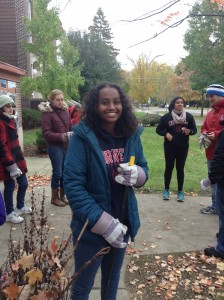
I think the best part was the last 10 minutes- when the director of GIAC talked to us about why Into the Streets even exists and how important it was that we were there. She thanked us for spending our Sunday afternoon raking leaves and reminded us that the center overworks itself in a lot of ways- there are a lot of needs in the community that need to be met and a lot of the small things, like fall maintenance, get overlooked. And that’s where we come in. It’s our job to help in any way we can.
Hip Hop Emerged
Wow. I mean just wow.
That’s all I have to say about Rubble Kings. Thats the whole post. Thats everything that needs to be said.
I can try to describe my experience with Rubble Kings, but it is almost definitely going to fall flat.
Rubble Kings tells the story of the origins of hip hop. It documents the lives of individual people as they try to navigate the gang-filled environment of New York City in the 1970’s. It talks about the ways the poverty and drugs can create a culture of self-loathing that can rip a community apart. It describes how violence can fill the void left by failure of the system.
But it also shows a community coming back. Discovering ways to thrive after everyone has decided they aren’t worth saving. Banding together to fight against their own destruction. Being united through music and a desire to keep living.
From all the pain and loss that the Bronx suffered at the hands of gang violence, hip hop emerged. It knit a community together.
After the film, there was a discussion with the filmmaker and one of the subjects of the movie, Afrika Bambaataa.
During this discussion, we talked about the ways in which performance, like hip hop, can be used for social change. This is one of my favorite things to talk about. I think that the only way for a society to move forward is for people to actively work against the things they want to change. For me, performance is the perfect way to do this.
Rubble Kings was amazing. I walked in with some interest in hip hop. I walked out ready to inspire change in my community.
Exposing the truth through documentary
Watching “Street Fight” last Tuesday was an eye opening experience to the world that is politics. The documentaries that I’ve usually watched all seemed to be just someone narrating or being interviewed, but Curry’s documentary “Street Fight” was somewhat different. I didn’t really get the sense that anything was being narrated. I felt as though Curry used his camera to really capture and expose to the public a controversial event, which just happened to be an election for mayor of Newark. I liked Curry’s style of doing documentaries because exposing reality as opposed to being told what happened by a narrator makes the documentary feel more “real”. I think that with this style of documentary, the audience can actually feel the excitement and disappointment of the main character(s).
The movie itself was pretty interesting. The movie basically showed what happened “behind the scenes” as the election for mayor of Newark approached. Curry did a great job at showing Cory Booker’s excitement and disappointment as well as Sharpe James lying personality. The movie showed how tense things can get between candidates for a mayor election and probably for any other political election. It showed how one candidate tries to tarnish the other candidate’s name and how lying can be used to manipulate people to be on your side when voting time comes.
Newark Democrats Duke it Out in 2002 Elections
Last Tuesday when I saw the film Street Fight by Marshall Curry, I had no idea what to expect. As a New York City girl who was 6 years old at the time, I had no recollection of the national importance the mayor election between Sharpe James and Cory Booker had on the people of Newark, let alone the nation. Marshall Curry depicts the story of the corruption, emotion, and raw details surrounding the election in his first documentary.
I found the documentary very interesting to watch and felt myself rooting for Cory along with Curry and the rest of his campaign. Even though Booker lost the election to incumbent Mayor James, I was surprised to see how much faith he still kept for himself and for Newark — the man really wanted to see a better Newark rise out of their local government. Booker himself grew up on the streets of Newark and knew the neighborhood well. I loved his genuine commitment to try to make Newark a better city for those who were economically struggling and his will to convince people on the streets why he should become the next mayor of Newark.
One of the moments that struck me the most during this film was during the slander surrounding Booker by his opponent Sharpe James. Booker was accused of being a correspondent with the KKK, that Jews were giving him his money, a lot of really ridiculous accusations in order to keep Sharpe the mayor for the next 4 years. Representatives for James ridiculed Booker for being Stanford and Yale-educated and even went to say he wasn’t part of the true black community because of his light skin. One of Booker’s representatives openly spoke about Booker’s character and believed in him as a good man, as well as his platform. “Don’t hate him because he’s educated, we should be wanting the same for our kids to be like him.”
I loved hearing about what Marshall Curry had to say about his film and what followed after the end of the documentary. Booker eventually went on to become mayor of Newark in 2006 and subsequently the Senator of New Jersey. A lot of people, himself included, were surprised at the success the film has had — it went on to receive an Academy Award nomination — especially since a large part of the work was Curry himself filming the streets of Newark alongside the candidates. I myself am proud to see how far this film has some and can’t wait to see what other works Curry has in store.
A varied perspective
The documentary by Marshall Curry did a great job of presenting both views of the topic. He was able to trace the beginnings of ELF and examine their motivations. He found great examples of where members in the group felt that the peaceful process had failed them. Curry allowed Daniel to speak freely which allowed to viewer to peer into Daniel’s viewpoint, but it also showed contradictions in some of Daniel’s views.
Curry’s take on whether the word terrorist was appropriate for ELF members was very balanced. He was able to show why the government thought the word to be appropriate, and why Daniel revolted against the word. The word arsonist really fails to describe what the ELF was doing. They weren’t burning down property for enjoyment or for monetary gain. They were destroying property to achieve a political goal. They probably lie closer to terrorists than arsonists; however, the fact that no one lost their life during one of their attacks does matter a lot. That isn’t enough to clear them from the label Eco-terrorists because, in the end, these weren’t victim less crimes.
Overall, Curry was able to weave together a story that sometimes spanned over the entire USA into a very well paced film with very intriguing characters. He was able to do it without getting lost in one side’s perspective. It was refreshing to learn about an issue from a format different from the news where everything was presented in a more calm way.
marshall curry with the shot
empowering.
I’ve been doing videos for quite some time; in high school, my friends and I made interesting quasi-educational videos to pass our classes. Some were of our signature chemistry rock band (https://www.youtube.com/watch?v=znQHIo6jhRk, https://www.youtube.com/watch?v=KipbQCWENIw)– others of short funny marketing skits (https://www.youtube.com/watch?v=7Pb1pfUY2pc), others rapping tonguetwistingly in Spanish (https://www.youtube.com/watch?v=nJQjXErDvtM), and others secretly playing pranks on people in public places.
But what Marshall Curry was doing took videography a step further, he took the gritty and real rolling images to a new level by giving a powerful and interesting undertone: a story.
I ended up watching Street Fight, and hearing about Marshall’s incredible story over dinner. He pursued his interests wholeheartedly, and for that reason he was incredibly empowering, especially to a guy who’s really into film.
Learning about documentaries
This week’s dinner conversation with Marshall Curry started with everyone introducing themselves and talking about their interests or experience with making movies. Many people were like me and had no experience with film-making. It was quite interesting to hear how his career path led him to become a documentary maker. He studied comparative religion in college, started teaching high school students. He eventually worked for someone who was making a documentary. He told us although things did not go well with the first documentary he became really passionate about making documentaries.
One of the interesting things I learned from Curry was that when making a documentary you have to capture moments that are totally unexpected in order to capture the audience’s attention. In other words, keep the viewer curious about what is going to happen next at every moment. In deciding whether to make a documentary on a certain topic, Curry said he focuses on whether there is a compelling narrative trajectory with an interesting beginning and end to the narrative.
Curry discussed some of the documentaries he has produced. One of them called “Point and Shoot” is about a man who was travelling to Africa and the Middle East and eventually joined the rebels in Libya to fight against Ghaddafi. The other one called “If a tree falls” is about the Earth Liberation Front and discusses whether ecoterrorism should be condemned or not.
I certainly developed a much deeper appreciation of what it takes to produce a good documentary on a compelling topic.
Try something at least once
During the informative, and very interesting dinner conversation, Mr. Marshall Curry had many pieces of wisdom to impart to us, however, one piece of advice particularly resonated with me. Mr. Curry told us to try something that you are interested in at least once, even if it seems almost impossible to accomplish. In his example, he was very interested in producing a documentary although he had little to no experience in doing so. Furthermore, many people who aspire to produce documentaries put in lots of time, money, and effort, only to see a low payoff. Thus, for Mr. Curry, producing a documentary was a risky move but he tried anyways because he did not want to look back 30 years later and regret not trying, and asking himself “what if”. Mr. Curry started filming the local election of Cory Booker and got hours and hours of film, but the editors and publishers refused to help him edit and publish his film. So, he had to teach himself how to edit and structure the film. Through all of these hardships, Mr. Curry was able to eventually get his documentary published and screened, and even got an Academy Award nomination!
Re-imagining an old hero
We are taught in history about the stories of legends. We construct in our minds what we think they were like. We in a way place them on a pedestal. Oddly enough as a result, it can be disappointing to learn something about them that we believe to be beneath them. However, I think what The Mountaintop taught me was that those legends that we look up to are all just humans. I guess when we imagined their lives, we didn’t actually imagine their lives. We imagined a figure, a hero. We didn’t picture them washing dishes, or complaining about their long day of work, we never really saw them as one of us. But in doing so, we lost some of the magic.
It was off putting at first I think to see Martin Luther Kind Jr. as someone who was tired of it all, who felt lost in many ways, who could smoke, drink, swear, and cheat on his wife. None of these things were from my childhood imagination. But as the play went on, I appreciated it more. It made what he did somewhat more magical in a way. Seeing him as a man and only a man who could then stand on the mountaintop and see the stories of history play before his eyes, it hit me of the impact that a person could make. He wasn’t some mystical being that was perfect or untouchable but rather an ordinary figure who had to deal with all the same emotions that we all have to deal with. He felt the same dilemmas that we all have to face.
The Mountaintop was so poignant because it provided us an insight into a legend but also into all legends of history. It was also powerful in the boundaries that it pushed. I loved that it made God a black, woman and an angel a prostitute who drank, swore, and didn’t care what any man thought of her. This play made me re-imagine not only the past and those who lived in it but also, how I see the present. The play was emotionally moving and didn’t allow any of society’s “rules” to govern the way it imagined the world, thereby allowing me to not let society’s “rules” govern the way I imagined the world.
Getting pumped for self-care!
There was something strangely satisfying about pulling out fistfuls of pumpkin goop during the self-care workshop last Saturday. I honestly went into it with a pretty bad attitude; I was planning on leaving early because it seemed like a waste of my time when I had prelims to study for. However, once the carving started, I gladly stayed the full hour and a half. It felt nice to focus all of my energy on cutting open a pumpkin rather than on trying to remember what happens when an alkene reacts with a molecule of mercury acetate. It was also an awesome opportunity to meet other Rose scholars and get excited for Halloween with them.
At a school as stressful as Cornell it’s pretty surprising that events like this aren’t more common. Cornell should hold a biweekly arts and crafts session or something, because every season here is prelim season.
Have a fun and safe Halloween everyone!
An interesting discussion on environmental issue
On Wednesday evening I went to watch the If A Tree Falls film by Mr.Marshall Curry. I found it very extreme for the environmentalist to burn down the timber factories because I think that is a very inefficient way to solve the problem. They probably didn’t care about the people that are going to lose job because the place they work for is burned down overnight. When people start to attack one another in a violent way, even the purpose is good, usually bad thing happen. And the environmentalist was imprisoned for over sever years. I think when people start these kind of physical protest in a group, it usually become a frenzy. I don’t want to judge the people in the group because I don’t know anyone of them. But burning down factories is not what sane people would do and I challenge that everyone in that group do it for the “righteous” purpose instead of just getting back at the society. I am not sure which site the director stands for or if he even wants to take a stand in the film, but I feel that the film is sending a sad message because this is a lose-lose situation where several properties are burned down to the group and the environmental problem is not solved. I really appreciate the people who strive for the cause, but it is hard to have it all. To have economics growth, we need to endure pollution and worse environmental situation.
Point and Shoot
In the Dinner Conversation event on October 25th, the two-time Academy Award-nominated filmmaker, Marshall Curry, came to Rose House to have dinner with us and share his filmmaking experience. Although it was a short event, we got to learn many things about him. For example, we learnt about how he went from being a comparative religion major to being a documentary producer, director, cinematographer as well as an editor.
We also got some insights into the messages underlying his documentaries. I got very interested in his documentary Point and Shoot, so I went on to YouTube to look it up. Point and Shoot tells the story of Matthew VanDyke who set off on a self-described “crash course in manhood”. While on a his motorcycle trip through Northern Africa and the Middle East, he struck up an unlikely friendship with a Libyan hippie. When revolution broke out in Libya, VanDyke joined his friend in the fight against Gaddafi. I think it was truly a great documentary because it showed how friendships can be formed in the most unlikely place and how life is what you make of it. However, what caught my attention when I found this documentary on Youtube was the comments the viewers left, both positive and negative. I believe a successful documentary needs to be thought provoking and that was what exactly this documentary was. It might have caused people to appreciate how Matthew joined the course of war just to help; other times, it caused people to think he was a “bored middle class brat joining the fight for islamism”. The thought provoking video led to all those stimulating comments, which lead the viewers to think even more. That, I think, is what made the documentary phenomenal.
Car(v)e for Yourself
So I think we can all agree that we’re pretty stressed at the moment.
But while we are in the midst of studying and doing problem sets and writing papers, let’s not forget we are actual human beings who need to eat and breathe and sleep, as it is so easy to do.
So take a break! Go watch a movie or take a walk or get that extra hour of sleep! Do something fun for Halloween! Care for yourself.
A Fall-Themed Stress Reliever
This event was a nice opportunity for sit down and just take a breather in the midst of all the prelim craziness. While I must admit that it didn’t teach me much I didn’t already know about stress and taking care of myself, I did get to carve a pumpkin, which I found to be an excellent way to destress. It was also incredibly refreshing to sit with friends and NOT talk about school. I really don’t do that often enough, and this event was a reminder that I shouldn’t feel guilty about doing so in the future.
*Update* My pumpkin is dead. RIP.
An amazing performance
The first thing I have to say is that this production was amazing. Not only was the play written really well, the actors gave a great performance. There ended up being several unused tickets from Rose which was a real shame because it was a fantastic.
This was my first time at the Kitchen Theater and I was pretty surprised by the whole experience. It was a small theater with a ground level performance area and limited seating on three sides surrounding the stage, making every seat a pretty good seat. Outside the stage area, people gathered before the show where there was food and wine being served.
Before the play began, one of the theater’s workers came out to introduce it and talked about the Kitchen Theater. The play was written pretty recently and has had numerous productions. She mentioned how it was clear that the playwright made bold decisions. She also asked who had been its patrons for the past 25 years, and there were several people who raised their hands. She then asked who was visiting for the first time, and even more people raised their hands. When she asked one person why he had come for the first time, he said that it because his wife told him he had to. I promise I have a point in telling this.
Spoilers Ahead
As the play started, I was surprised at the quality of the production. The rain and its sounds from outside the window and the amount of detail in the set (which I guess is pretty necessary when the theater is so intimate), was great. The play started off with MLK settling into his room and calling for some coffee. A little bit later, Camae comes in with some coffee and a newspaper to cover herself from the rain. MLK is clearly intrigued by her and they start talking about the civil rights movement and his speeches. It felt sort of weird seeing MLK flirting with the maid, especially because he had just called home to talk with his wife and say good night to his daughter.
The portrayal of this American hero as a human who smokes, drinks, and possibly cheats was very jarring. At times, it was sort of uncomfortable to watch. As they talk, the rain keeps coming down and whenever lightning and thunder occur, MLK is super sensitive to it, causing the audience to worry about his health. As Camae pushes his buttons about how marching is not effective enough, MLK starts to break a little. He talks about Larry Payne, a sixteen year-old innocent boy shot by the police. What broke my heart was the fact that 50 years later, the same thing is still happening. The language sounded so familiar and resonant, but this happened during civil rights movement, something we tend to think of as in the past and as history, but stories of racial police crimes happening is still (perhaps more) prevalent today.
Camae is still not satisfied with his pacifist ways of fighting the system and decides to emulate him and give a speech on what she would say if she had the influence of MLK. It sounded amazing, but it made me think about why we trust effective speakers. This was an actor performing words written for a character she is portraying, but it still felt genuine and real. When politicians make rousing speeches and the like, why are we inclined to rally and support them. I just found myself thinking about all the people who are particularly good public speakers and how I always feel dubious when someone is so clean when speaking confidently. To me, sometimes it just doesn’t feel genuine, perhaps because it feels too rehearsed.
Afterwards, they talk some more about violence versus peace and end up talking about heaven. Clearly from his background, MLK wants reassurance that God is pleased with his work, and Camae insists that she is happy and is “in like” with him. As the next lightning strikes and MLK grabs his heart in response to thunder, she freaks out. Camae tries to calm him down but starts calling him Michael. At first, I was confused because I had always thought, he’s a Jr., his name isn’t Michael, did the actor make a mistake? MLK suddenly gets enraged because only a handful of people knew about his Christian name and becomes convinced that she’s a spy sent to seduce him and starts to look around the room for wires and starts to push her out the door.
When he opens the door, snow falls onstage and is in awe that it’s snowing in April. “It snow sometimes in the spring here” was great comic relief, especially for an Ithaca audience, during such an intense struggle. MLK returns to freaking out thinking that he’s seeing things and that she’s drugged him and to finally shut him up, she reveals that she’s an angel. ! Plot twist!
She says that she was sent to take him to heaven. You’d think he might start freaking out again. But instead he’s curious about God (who is apparently a black woman more beautiful than you can imagine) and the circumstances of his death. When she reveals that it’s going to happen tomorrow, then he starts to properly freak out. He frantically tries to work on his speech because he doesn’t feel like he’s done enough, that he hasn’t finished what he set out to do. He tries to negotiate his way into having more time on earth and a frustrated Camae gives in and calls God on her cellphone. MLK speaks to God (we only hear his side) and states his case, and God hangs up on him. MLK gets sassy and Camae hits him with a pillow and starts a pillow fight which ends with a strange tickle fight and as it stops, he starts to break down.
He asks why he was given this task and that he’s just a man. He tries to call home to say goodbye to his wife and daughter one last time, but they don’t pick up because it’s late. As he recounts getting her flowers before he travels in the hopes that they won’t die before he returns, he remarks on how this time, he bought fake flowers, so they could last her forever. At this point, looking around at the audience, a bunch of people were wiping their tears, including myself. There were couples clinging to each other and the man at the beginning who came only because his wife told him he had to was fighting to keep his composure, but really couldn’t.
As he asks more about how he will die, he makes sure to ask about the future. About how the civil rights movement will proceed after he’s gone. The backdrop opens to a projector with names and events of the future (our past). MLK climbs up some steps and reaches for the light. “The baton passes on,” she says repeatedly, ending with Obama. As he continues to look into the light, he is amazed at what utopia the future could be. As he is finishing, he walks to the balcony of the hotel room and Camae comes in to take his hand and the play closes.
Overall, it was an amazing performance. The play was the perfect mix of comedic and tragic. The subject matter was provocative and the dialogue was eerily relevant. I would definitely recommend everyone see the play or at the very least read the script.
A standing ovation for the actors
A New Dance
I love learning about bodies. Whether it is about the brutality of black bodies or, in this case, how we come to understand our body. In this workshop, I had the pleasure of dissecting how I’ve come to know my body through food, exercise and words. After this workshop, I came away with the understanding that accepting your body as whole is a dance.
I love my body and fully accept it as it is. I haven’t always been able to say this. For a long time, I thought my body was a dirty and ugly vesicle, unwanted and forgettable. I haven’t always been confident and it was an arduous process to get a place where I can fully claim and praise my body. I realized that once I gave my body meaning (more importantly, acknowledging that God had already given my body meaning), there was a shift in the way I carried myself. No longer did I worry about what others thought of my body, no longer did I question how attractive my body, no longer was body about politics, sex or their economy. It was simple purposeful.
I’ve always been different. Additionally, I’ve known that I was suppose to me different. But, when you are surrounded by people who don’t look like you or value your body, it is hard to see its diversity as beautiful. When I accepted the fact that God made be to be distinguished and extraordinary, it was easier to see that a ordinary body, mind or soul was something I never wanted.
While the details of this workshop are of little importance, the affirmation that I received from the fellow attendees is what this workshop meaningful.
I can confidently shout that I love my body but that doesn’t exclude me from the doubt, micro-aggression, racism, and sexism that my body receives to diminish its purpose. I know that coming to the specific and recognizing my power has allowed me to continuing dancing a new dance with myself.
An Unusual Study Break
This Rose Event had to be among one of my favorites. Reading the description of this event, “Self-Care Workshop”, I expected to attend a lecture that talked about the ways students should handle stress and taking care of oneself during these times. Yes, there was a brief introduction; however, when I walked into the Rose Library, I was pleasantly surprised to see pumpkins & carving kits set up on the tables along with joyful and smiling faces. I had no idea that we were carving pumpkins, so I was in for a treat. I had never carved a pumpkin all by myself before and had been studying hard for one of my prelims beforehand, so it was a great 2-in-1 where I was able to take a mental break and try my hand at carving a pumpkin.
The Rose House faculty could have easily put together a powerpoint and presented their ideas about self-care. Instead, they decided to take the extra step and plan out this unique hands-on activity, which is something I appreciated. While carving my pumpkin, it was nice to converse with other Rose Scholars at my table that I hadn’t met before, which allowed me to connect with others in the Rose community. Good vibes & upbeat music filled the air and laughter was interconnecting all of us as we tried to clean out the pumpkin’s insides.
Overall, I truly enjoyed this activity as it provided me with something I was craving: arts & crafts. As a child growing up, arts & crafts was an activity that was my creative outlet and a huge part of my life. Being at college suppressed and limited the amount of time I had to do artistic things and this activity rejuvenated something within. It also showed me how important it is to take care of your mental health, even if it is for an hour long, by being surrounded by positive attitudes and creative spirits.
I really needed that
So this past week and the week before have been kinda stressful. The prelim I was most dreading was this past Tuesday and I was going crazy last weekend. I’m so glad that we had the opportunity for the self-care workshop, because I know I hadn’t been taking care of myself the way I should have been.
Carving pumpkins is a mindless task, and that is exactly what I needed to do for an hour. Something that didn’t require a lot of brain power, something to help me relax and give my brain a break from working through thermo problems. Something that I could do to just laugh and have fun. I really really needed that.
And even though I love going to all the educational and eye-opening events the Rose Scholars provides us with, I have to say that this one was pretty awesome. And it wasn’t just that I needed a break; it was also the fact that it gave me an opportunity to meet new people in Rose House that I probably wouldn’t have met otherwise. We talked about favorite past Halloween costumes and which scary movies are the most scary and our own personal holiday traditions back at home. I hope we have more events like that in the future, where we can just laugh and talk and meet new people. It was definitely the break I needed last weekend.
Terrorist or Hero? A Neutral Critique
This Wednesday, a documentary named “If A Tree Falls” by Marshall Curry was showed at Cornell cinema. This film is both interesting and thought provoking, providing us with a different perspective to look into those crimes. It is debatable when it comes to giving a definition to those environmental fanatics. Terrorists or heroes? It is not proper to just simply make a judgement by looking only at one dimension of their action. To get a comprehensive understanding of this issue, we may consider evaluating their motivation, approach and consequences caused.
Undoubtedly, Daniel and his friends have a right motivation that they care for the environment and have great enthusiasm of protecting our ecological system. A detail was mentioned about Daniel that he would recycle every single piece of paper in his daily life. Actually, I think we need more people just like Daniel in our society, who has formed strong awareness of caring for our environment.
However, the way they approach their goal is radical and extreme. The consequences caused are serious individual property damage and loss. But try to think that if you consider it in a whole picture, after burning down one timber factory, there are still thousands of timber factories standing and as long as the timber is demanded for use, more factories will be reestablished to meet the demand. The root of this problem is a contradiction between the increasing demand of human beings and the need for protecting the environment. The government should be responsible for the role of balancing these two aspects and improving the law system as well as the market management. It could be possible for the government to set up additional tax and set a high price for logging using market mechanism to make it relatively expensive to cut down trees. Thus, policies can be used to lead the behavior of consumers as well as timber factories incorporating the externalities of environmental damage caused by logging.
In contrast, the arising of radical behaviors like damage caused by ELF is also a reflection of the deficiency of current policies and bad behaviors of authorities. They did the damage because there is nothing else they can do to make a real change. We can see the protestors walking among the street but were treated with violence from local police. We can also see people who were trying to prevent the tree from being cut down were driven away and even arrested by the police. These scenes were not supposed to happen in a country that respects the rule of law. Maybe there should be a seminar led by local committee discussing the issue whether the tree should be removed with democracy considering all the aspects of interest. Unfortunately, they cannot find a way out. From this perspective, their actions seem understandable.
Finally, in my opinion, this case should not be a case used to arguing and studying how to deal with, definite and sentence those crimes. Instead, it seems more like an alert that the conflict and imbalance of human and environmental resources is sharply rising and gives us a push to improve our current system and seek for more effective policies to solve to problem.
Carving the Stress Away
The self-care workshop last Saturday involved a topic relevant to every Cornell student….STRESS! Balancing prelims, assignments for other classes, extracurriculars and a social life, stress is bound to make an appearance in your life somehow. Honestly, I didn’t really plan on going to the workshop, I figured I would reduce the stress in my life by starting to study for my prelim later in the week instead. It was ironic, but I would up going to the self-care workshop in the Rose library and I am sooo happy I did!
GRF Sarah had some great tips about dealing with stress like exercising, socializing and using mental health resources on campus. During the week, I found myself using a lot of these tips to deal with the stress from my prelim except that I vented more to my roommate and best friend than a counselor. Finally what better way to deal with stress than carving a pumpkin!!! I only carved one other pumpkin in my life before and I found it so difficult so my dad wound up taking an electric saw and cutting the pumpkin for me. (So I guess I never really carved a pumpkin before!) It was really nice just taking time out of my day to relax, talk to other Rose scholars and carve a really cool pumpkin (see the picture below)! I found it carving the pumpkin to be much easier than the last time I tried and I think my pumpkin carving skills speak for themselves with the picture attached. Overall, I loved the workshop and I got to take the pumpkin back to my suite to decorate our common room for Halloween. Unfortunately, the pumpkin started to mold and decompose in our living room so I had to throw it out about five days later but at least the self-care tips are staying with me for longer.
Squash Carver Extraordinaire
Unfortunately, it never occurred to me to take any picture of my pumpkin, but be assured it was the greatest in the world. Though it got a little moldy, so I let it sit outside under a nice tree. So now if you see a jack-o-lantern between Rose and Becker, you know who put it there. Unless that’s against the rules, or something. Then I had nothing to do with it…
The self-care workshop was definitely a great time. A CAPS counselor from Gannett came and talked to us about some ways we could help manage our stress. Given that it was around the first set of prelims, I think the advice was very welcome. It seemed the tip she stressed the most was to get a full eight hours of sleep. We’ve all heard it before, but it really is simple. Although I am happy to say, I always get at least seven and a half hours!
As for my pumpkin, it wasn’t actually that great. I cut myself with the children’s carving tool within a minute. Once that was all cleaned up, I promptly broke the tool on accident. Somehow, I did eventually get through carving the pumpkin, and made some friends in the process. So in the end, it was a great way to relieve some stress and just get away from my homework for a little while.
Carving your way out of stress
Pumpkin carving was a much needed break in between orgo studying. It allowed me to realize just how important it is to take care of yourself mentally and physically when life demands it the most.
When you have prelims and assignments due every week, there is constant stress and tension. You feel like any time you are not studying or doing something productive, you are just wasting your life away. However it is exactly in these moments that you should be doing something mindless and entertaning to relief stress, because the more at ease you are during a time of tension, the better your performance will be. A healthier mind, yields better results!
.This Rose Scholars event was definitely a hit, hopefully there is more of this type of events in store!
Nandan Amladi
Nandan Amladi’s background is quite similar to mine. He did his bachelor’s in electrical engineering and pursued a masters in computer engineering. After completing his masters, he worked in the software field for a few years before going on to pursue his MBA. What fascinated me most about Amladi was his versatile education graph. Switching from engineering to business is a difficult transition but also very worthwhile in the end. I was very interested in knowing what pushed him to get an MBA whether it was his boredom of working in the technical field or his desire to become a leader in his field. During my dinner conversation with him, I found him to be a very ambitious man who is passionate about pushing the boundaries in digital technology.
Even though Amladi is the vice president of the software sector in Deutsche Bank, his engineering knowledge is still intact. I was impressed by the length at which he spoke about the integration of computer hardware and software in the banking industry and provided us with his outlook on the growth of cloud computing in the software sector. Amladi also stated that he and his company keep a track of startup companies that are coming into the public space in order to predict the outcomes of these businesses. His awareness of the startup and tech culture around him suggested that he was a man who was very much involved with the progress of software technology in the coming years. By advising us to dive into startup culture right after graduation, he showed us the value of starting one’s own business instead of heading straight to industry. He told us from his experience that switching to the business field was the best decision he made because he became less constricted by the demands of his jobs and more free to explore new opportunities in software. As an electrical and computer engineering major, I was inspired by the way in which Mr. Amladi carried his work throughout the years; moreover, I was inspired to see that he hadn’t lost touch with his engineering roots.
Pumpkin Carving!
This has definitely been my favorite Rose Scholars event so far. I had just finished my first round of prelims, so I decided to go to this self-care workshop to destress and relax a little. They set up a bunch of pumpkins, tools, and decorations on the tables in Rose Library. I had never carved my own pumpkin before, so I was pretty excited.
Before we started carving pumpkins, a special guest (and Rose House Fellow!) came to talk to us about managing our health and well-being at Cornell. Sarah, a CAPS counselor, told us about the support services available to us. Sarah also carved her own pumpkin with us later! Below are some pictures of my pumpkin.
Before:
And after:
My roommate and I brought our carved pumpkins up to our room, but we unfortunately had to throw them out after ~4 days due to horrifying amounts of mold that aggregated.
Self-Care and Pumpkin Carving
Academic life at Cornell is undoubtedly rich and valuable, although it can also be one of the most stress inducing aspects of a college student’s life. Everyone has his or her own way of coping with stress. Some people like to run marathons and others, like myself, prefer to binge eat pounds of chocolate and peanut butter. In attempt to avoid extreme weight gain, however, I’ve adopted a healthier alternative to relieve stress, that being practicing yoga. Over my past two semesters at Cornell, I’ve learned that taking just thirty to sixty minutes out of my daily life to stretch, exercise or even meditate has truly improved my productivity, motivation and energy. During last Saturday’s Self-Care Workshop, Rose GRF and CAPS counselor Sarah Rubinstein-Gillis discussed various ways to manage stress during busy, high-pressure times. Some techniques Sarah addressed involved taking the time to exercise, color, reach out to friends, utilize on-campus mental health resources or even carve a pumpkin, as we had the opportunity to do during the workshop. Even though I failed miserably at carving a scary looking cat and I left Rose with pumpkin hair under every fingernail, pumpkin carving was the perfect break from studying organic chemistry nevertheless. Manipulating something other than a molecular model kit and meeting and speaking with other human beings were exactly what I needed to clear my mind and to mentally prepare myself for a stressful upcoming week of prelims. Aside from learning that I would make a horrible surgeon, I ultimately realized that that self-care and mental breaks are the keys to stress management.
Domestic Violence Has Many Voices…They Aren’t The Same
During Cornell’s Mental Health Awareness Week, I attended two events that focused on Domestic Violence Awareness, typically celebrated in the month of October.
The first event I attended was hosted by sororities in the Multicultural Greek Letter Council – women of color. The second event was hosted by the Cornell’s Women Resource Center and the Voices of Planned Parenthood – predominantly white women. The feel of each event, the dialogue, the tone, and the topics were very reflective of those in the room.
Perhaps I identified more with one group than the other, but it that doesn’t change the significance of having these conversations, how efficient these conversations should be, and the hoped for outcomes. With Domestic Violence, these conversations should be fluid, conscientious of the many identities that are affected, and ways to make these spaces seem open. All in all, domestic violence is too touchy of a topic, and I believe that it is the job of the facilitator to address the many voices affected, in order to create a safe and aware environment.
A Creative Endeavor
My absolute favorite Rose event thus far was definitely last week’s mask making at the Johnson. Admittedly, the event was very different than I had initially perceived. I thought the event was going to be a quick masquerade style mask making festival with feathers and plastic string masks. To my surprise, the event was so much cooler: we took a quick tour of different historical masks used for tribal rituals and festivals. From there, we walked into a very artsy room, we got our own smocks, we chose our own paints, and we got a blank imprint to design.
Those 90 minutes were the most relaxing 90 minutes I’ve had since I’ve been here: no school, no work, no prelims; it was just me and my thoughts. I spent about half the time trying to figure out what colors to use and how I wanted the mask to look. The whole process was very stress-free and it allowed me to just sit down and think about my life (one of those deep introspective conversations).
Here are the masks we made:
Mine is the red one; my friend made the black (much more creative, artsy) one.
Politics and Political Machines
This Tuesday I went to see a screening of Marshall Curry’s film Street Fight at the Cornell Cinema. The documentary covered the 2002 race for mayor in Newark, New Jersey in which Cory Booker, a political newcomer, ran against Sharpe James who had been mayor of the city for over 30 years.
I was amazed at the level of corruption that existed in the city government during this race. Curry interviewed many residents who described being threatened by the city police with the loss of their businesses if they openly endorsed Booker, and the film showed footage of police officers tearing down Cory Booker signs on Election Day. Sharpe James himself made derogatory comments about Booker and accused him of being a “carpetbagger” and not really African American. I kept expecting throughout the whole film that Cory Booker would win, so at the end I was very surprised and disturbed that the James political machine was ultimately able to beat Booker through the use of these corrupt tactics.
At the end of the film, Marshall Curry took questions from the audience and talked about the reception of the film. For me the most memorable part of his talk was when he described the international reaction to the film, and how people from all over the world have told him that this race was similar to elections in their hometowns. This film really made me aware of the amount of political corruption that is still present in our society and around the world.
Documenting the Art of Life with Marshall Curry
Last Wednesday, we had a dinner conversation with Marshall Curry, a Brooklyn-based filmmaker of Academy Award nominated documentaries such Street Fight and If a Tree Falls. When I first signed up for the event, I had very little knowledge about filmmaking and documentaries, but I was excited to learn something new. One of the lasting impressions I had was that Curry was a great story teller- I was absorbed in the account of his career path and from the beginning to the current. Curry had no intention of becoming a documentary film maker, let alone an Academy Award nominee. He was a religious studies major in college and wanted to become a teacher. Then he went to Mexico with a couple of friends and later decided to make a film for fun and follow his passion because why not? The unknown film project about a local election Curry started out of a hobby would go on to become an Academy Award nominee, but not without hard work, rejection, and years of editing.
The Complexities of Environmental Terrorism
If a Tree Falls: A Story of the Earth Liberation Front, a documentary that focuses on one man’s experience with extreme environmental activism and the subsequent legal proceedings that occurred as a result of his acts of “eco-terrorism,” is a brilliant film that raises multiple thought-provoking questions about the way we interact with the environment, the extent to which we are willing to stand by our values, and the way the same action can be viewed in so many ways by different people who admit that events are much more complex than they sometimes initially seem.
Besides being adeptly crafted to tell an intriguing history, this film really goes beyond the realm of story-telling in successfully making the audience think about how we, as a society, define terrorism, and how the current legal system seems to punish those who arguably least deserve to be punished, while letting others off free in exchange for information. It makes people think about how there isn’t one right approach to a problem, and that even individuals that seem to be clearly on one side of an issue have the capacity to sympathize to a surprising extent with others who hold conflicting beliefs. One striking example of this was a brief interview with a lumberjack in the Northwest, who openly acknowledged that he has no issue with cutting down trees. Though this seems crass, he goes on to explain that ninety-five percent of Old Growth forests have been cut down in the United States, and that when activists try to protect the remaining five percent, he doesn’t see this as being extreme. Extreme is cutting down all the trees. This really puts into perspective the extent and severity of the damage that we’ve inflicted on the natural environment. It forces us to think about our priorities and suddenly turns “radical environmentalists” into benign humanitarians. Equally as shocking were the scenes that showed peaceful protests wherein hundreds gathered to voice their political opinions, only to be met with police brutality. One scene showed a woman being held down by a police officer as he forced pepper spray into her eyes while she begged him to stop hurting her and told him that all she wanted was to protect the trees. These scenes were extremely powerful as they illustrated an aspect of the story that elucidated the way in which the lines between “good and evil” are really a matter of perspective and can be seen as blurry at best.
Walking into the theater, I was hopeful that I would enjoy this movie and perhaps learn a few new things. I didn’t expect to be blown away by all the intricate and fascinating questions raised by this film. Being able to ask the filmmaker, Marshall Curry, himself about the film afterwards was an added perk that added depth to my understanding of some aspects of the movie. If you didn’t have the opportunity to attend this screening, I would absolutely recommend that you find this movie to watch on your own-it’s definitely worth the time!
Education & Cultural Identity
“If you can feed them, you can lead them.” This is the political culture of Newark, New Jersey – a city with staggeringly high poverty and murder rates. Marshall Curry’s Street Fight documents the intersection of race, identity, and democracy in the city’s 2002 mayoral elections. In this city, elections are won and lost in the streets.
The race was between Sharpe James, a powerful and sketchy incumbent, and Corey Booker, an all-American, Ivy League-educated rookie. I label James as ‘sketchy’, because of the tactics he used. Supporters of Booker were threatened. Businesses that hung Booker’s posters were dissuaded by promises of code enforcement shutdowns. Accusations about Booker being white, Republican, Jewish, and associated with the Ku Klux Klan were made. Basically, he played dirty.
One of my favorite scenes from Curry’s documentary was of Corey Booker wearing a Stanford Football Rose Bowl shirt in his Brick Towers apartment. Interestingly, Booker’s academic success was one of the main ‘issues’ James slandered.
Why? Because, the way James saw it, an educated black man is essentially white. This belief represents a problem seen all too often in American society- that being an educated minority is misconstrued as cultural abandonment. Phrases like, “you talk so white” and “you’re not really black” are quintessential examples that too many have heard. Academic success should not lead to hardships in cultural identification.
It is a frustrating idea, and I would like to thank Marshall Curry for documenting a story that transcends beyond the corruption of politics and sheds a raw light on the judgments minorities with academic accomplishments sometimes face.
Can Environmentalism be Terrorism?
Memories of Sweet Salad
At the Love Your Body event, the first thing we talked about was how our favorite foods and their tastes affect the way we feel. The discussion was enlightening because I realized that people have very different sentiments regarding foods and the memories they evoke. One person said he loved pasta and that the tomato sauce reminded him of the fact that he used to hate tomatoes when he was a child, but was forced to eat pasta anyway. The speaker said that fruit cake brings forth memories of her mother’s concern for her weight. She said that she was a stout kid, so her mother always gave her fruit cake for her birthday as a healthy alternative to standard birthday cakes. Another person said that his favorite Indian chicken dish reminded him of his home and heritage in India. I talked about the pomegranate Waldorf salad that my uncle always makes. The salad reminds me of the relationship my uncle and I have and my first introduction to the delicious pomegranate seed. For me, the fruit in the salad invokes cheerfulness while the walnuts give an earthy, homey feel. Food can be something we eat as a means to survive, but it can also elicit all sorts of memories. I appreciated how the definition of “body” was broadened to encapsulate senses, emotions, and thoughts as well.
Learning about other people
A few days ago, I went to a workshop called “Love Your Body”. Since it sounded so strange and weird (and sort of creepy), I decided to go.
In this workshop, we talked about how we react and think while conversing with another person. We talked about how the average person prefers not to share much personal information about themselves. We were pared up into groups of two to converse about something personal with a stranger; our favorite food. I ( and probably many other people) found this a bit strange and awkward. Because my favorite food is Spaghetti, I tried to describe to my partner the reasons why I liked that specific food so much. For example, I explained the nice fragrance of the food, how the noodles are just so easy to eat, how the sauce has the taste of umami, etc. (I know, this sounds weird). Next, we were supposed to relate how these foods were connected to our childhood. Luckily, I wasn’t the only one who found this question a bit challenging.
The main idea of this workshop was to learn about how our character and identity is shaped based on our past experiences and surrounding. I found this psychological study about ourselves quite enjoyable. It is interesting to learn that without even knowing, our daily movements are shaped by our surrounding environment. For example, when I went to grade school in Japan, I was one of the tallest kids in my class. Everyone around my always mentioned how tall I was, and I hated it! As a result, I always bent my back and never stood up straight. When I later came to the United States, I was considered average hight (even a bit shorter than average). This made me stand up straight again and not feel self conscious about my hight. Therefore, my physical appearance changed overtime based on my surroundings.
After the lecture, I realized that humans are like herds of sheep. They try to move with the crowd and not stand out. If they do stand out, it could make them feel vulnerable or isolated from the pack. Even though we like to think that we are independent from one another, it is important to know that no matter how “independent” we might be, we are still greatly influenced by the society around us.
An Afternoon of Pumpkin Carving
This past Saturday, I attended the Self-Care workshop in the Rose library. This was one of the most interesting events I have participated in Rose. Not only did I learn how to carve a pumpkin, but I also learned more about the health resources available at Cornell. I am very glad I spent my Saturday afternoon to get in the Halloween spirit.
I had a good time carving the pumpkin and taking out the flesh. It helped me reconnect with nature, and I found the physical act cathartic. I liked that I could create any design I wished, and the freedom was indeed an effective stress reliever.
During the event, I gained more insight into limiting stress by taking advantage of resources such as CAPS and EARS. Especially because many students have prelims at this time of year, the workshop was helpful! I also got to meet a lot of Rose scholars, which was fun! I realized that Cornell’s environment is stressful for everyone and that we need to care for ourselves and each other. One notion that Sarah, a CAPS counselor, shared that resonated with me was that we are not robots. We are human, and we need to time away from academics to recharge.
The “Environmental Terrorism” Documentary
Tonight, I went to see a documentary on deforestation in the United States by Marshall Curry. The story was about this one man living in New York who was arrested for being an environmental terrorist. You are probably wondering: What the heck is an environmental terrorist? Is it a tree hugging Osama Bin laden? The short answer is “NO”.
To explain what an environmental terrorists are, it is first important to understand that these so called “terrorists” are just normal educated American men and women who were just trying to protect trees from being cut down. In the beginning (or before environmental terrorism existed), a group of environmentalists were protesting against large logging companies that were cutting down large sections (90%) of forests in the state of Oregon. Note that these were peaceful protests aimed to stop the rapid deforestation. However, these peace protesters were eventually arrested and brutally tortured by the law enforcement officers. They thus realized that these peaceful protests were not working because they repeatedly lost the battle to the large logging companies. Since these environmentalists were overpowered by the large corporations, more protesters resorted to physically harming these logging companies. They started burning down buildings and destroying property that was owned by these companies. During these more violent acts, the protesters always made sure that they were not putting anyone’s life at risk (even the CEO of the lumber company!). These “burning demonstrations” spread rapidly throughout the United States to areas that were trying to stop deforestation. This one guy that I first mentioned was a man who previously participated these burning protests. He was sentenced to lifetime imprisonment. Other people like him were caught and were also sentenced to lifetime imprisonment and would be labeled as terrorists for the rest of their lives.
Does this seem fair to call these environmentalists “terrorists” I don’t think so. Just because a person does something against corporate America does not mean they are terrorists. To me, these were just concerned citizens who were trying to save the last 10% of the forests before the mountains were totally bare. Though I do think these protesters might have gone a bit too far by burning down the factories, I also do believe in equal representation. Because the governments were in cahoots with businesses involved in the logging industry, they tended ignore the concerned citizens. Because the protesters were not gaining any political attention, they had to resort to a bolder way of protest; destroying. Because they did not injure anyone during these protests, I think these “environmental terrorists” should have instead been called “environmental protectors”.
With all the environmental problems we face today, I think that it is important to note that these problems will not just go away. We have to deal with the consequences and try to prevent any further destruction before it gets worse. It is unrealistic to think that we will find another habitable planet any time soon that will “act as a spare when the earth wears out”. We need to think more “down to earth”. It can even be as simple as being thoughtful about the items you consume in your daily life. So go forth and be an environmentally conscious person, or as some would call it an “environmental terrorist”!
ELF: A Story of Eco-“Terrorism”
Consider the following questions:
1) If a tree falls in a forest and nobody hears it, does it make a sound?
2) If a tree falls in a forest and nobody hears it because the sound of sawing is so deafeningly loud, do you then set fire to the headquarters of the lumber company?
The first question has been debated time and time again, conflicting over differing points of view, having different ways of judging the same scenario. The second question seems a bit less up for debate, but surprisingly has also encountered a dangerous range of responses– as can be seen in Marshall Curry’s documentary, If A Tree Falls. The Earth Liberation Front (ELF) was an organization set on saving the environment, mostly through property destruction in the form of arson. Although this was certainly a moral and legal wrong, the term applied to the members of this group makes me feel uneasy. “Eco-terrorists” is the label they have been given. The judge may argue that everyone who inspires fear is a terrorist, but given that the word terrorist inspires a reflex of instant hatred in a post-9/11 world, it seems like a gross misrepresentation of the group’s motives and desires. They never hurt anybody physically. They never threatened human life. In fact, they actively tried to avoid harming others. Even when they were busy burning buildings to the ground, they always made sure they were empty before they begun. Not only were their methods , but the reason for the birth of the group was understandable. Police were brutalizing non-violent protestors– inevitably, some protestors reached the conclusion that another path would have to be taken to get any sort of real results.
Property destruction? Sure. Wrong? Of course. Jail-time? Makes sense.
Terrorism?
I think not. But if a tree falls in a forest…
Two faced
Painting masks at the Johnson was exactly what I needed–an hour set aside to de-stress and do something creative. After looking through the museum for inspiration, one of the collections of masks stood out to me: there was a set of black and white masks, where the black masks represented evil and the white purity and goodness. Drawing from this I made my mask half white and half black, but with some details to counteract the strict good/evil separation. The black half has gold swirling across its cheeks in a tree like, flowing pattern, to show that even darkness has filaments of light drifting through it. The white side’s face has tears falling from its eye and a deep blue, crack-like pattern across it to represent how there are always faults even in the purest people. The golden mask around its eyes is for the masquerade we all play, both light and dark.
Finding Your Passion
Yesterday evening, I heard Marshall Curry speak about finding himself and ultimately “finding” or creating great documentaries. Initially Curry studied religion and decided he wanted to be a teacher, however, while interning, he discovered he could not handle disciplining students. So after going back and forth between what to do, he made a spontaneous trip to Mexico. Afterwards, he made another spontaneous decision to make a movie, just so he could say he did it. Curry ended up filming the election of a local man who was running for senator. He made sure to bring out the key issues in the race: politics, passion, and discrimination. Surprisingly to Curry, his film after nearly two years of work, was so successful that it was up for a Grammy.
He then went to describe what went into a great documentary. One thing he mentioned was the transition in a documentary that had a beginning and end. It keeps the viewer on his or her feet because the viewer wants to know what happens next. Also a charismatic character that engenders any strong feeling in the viewer makes a documentary memorable and entertaining. Lastly, he feels that a story that has yet to be told is an entertaining from a lack of knowledge standpoint.


